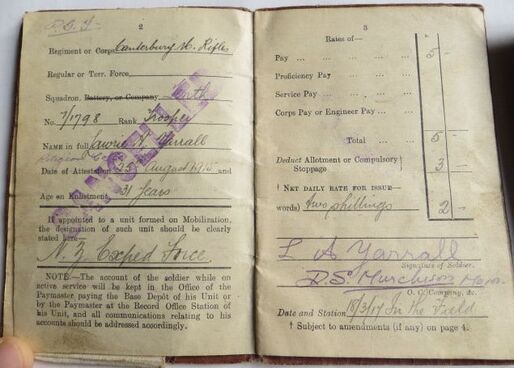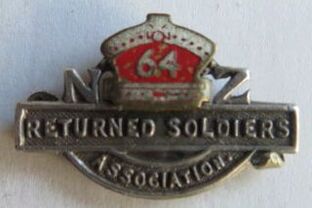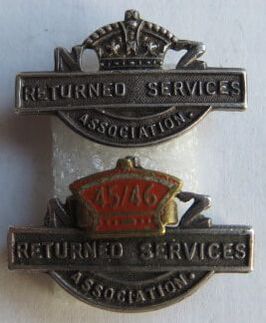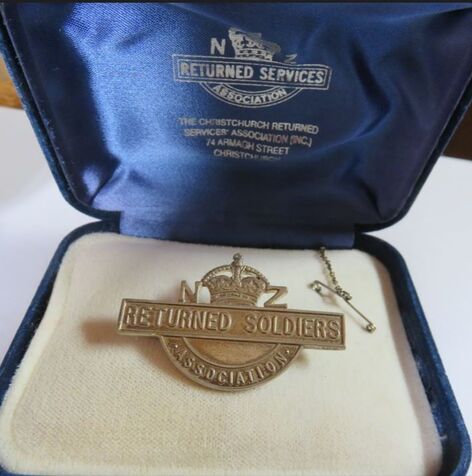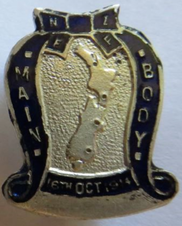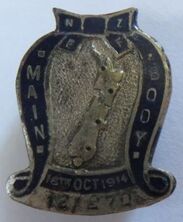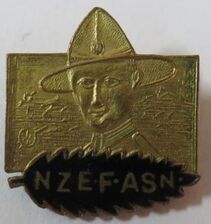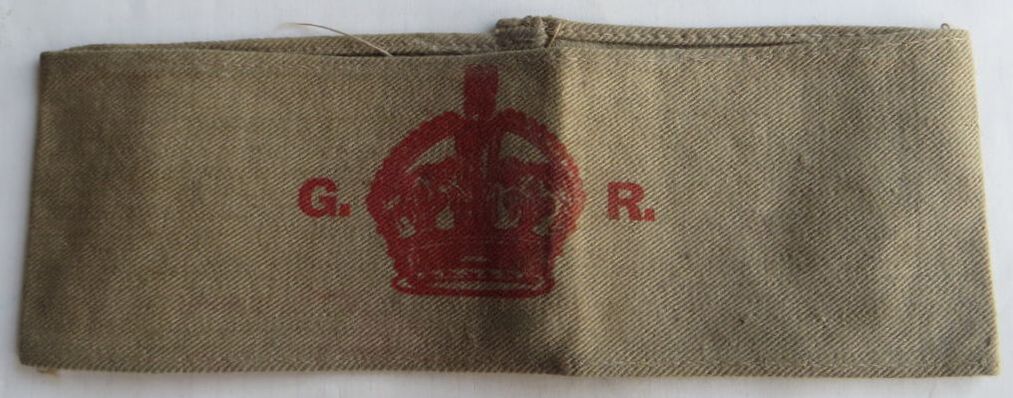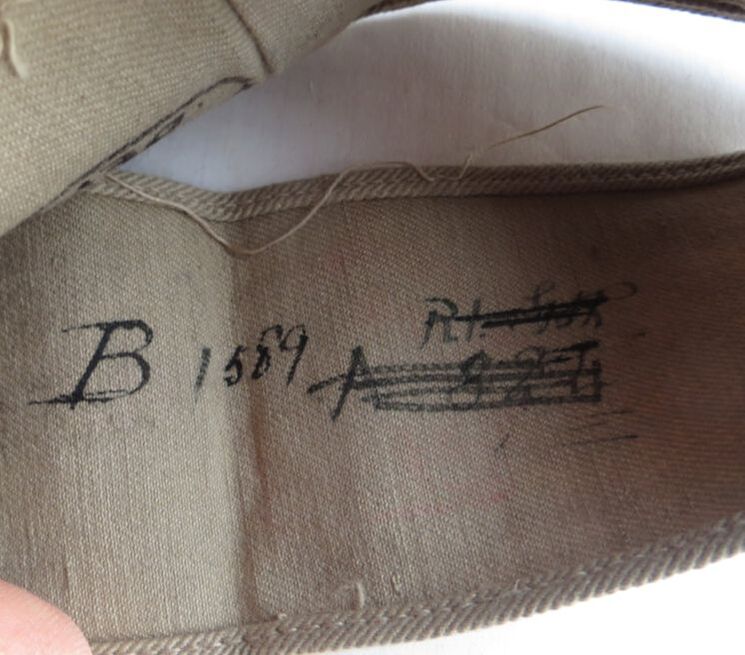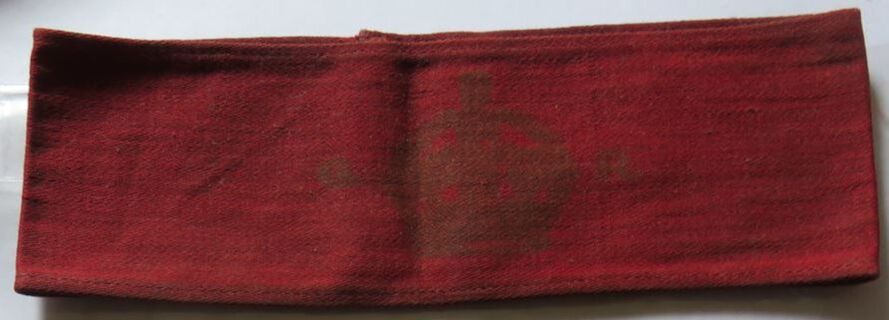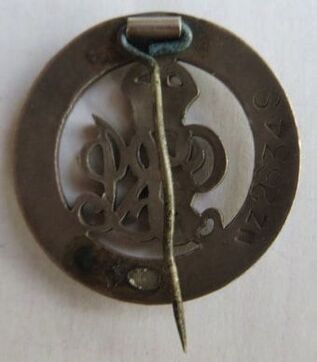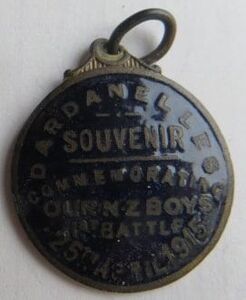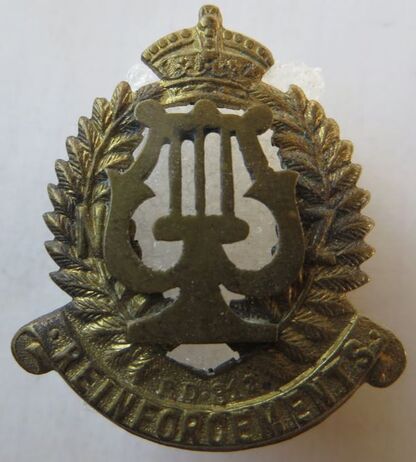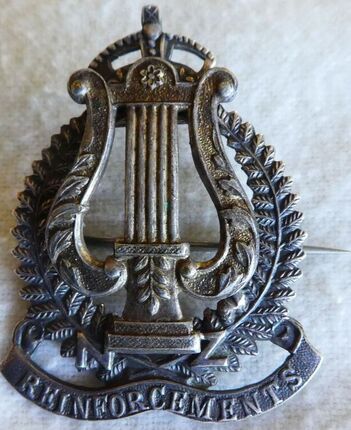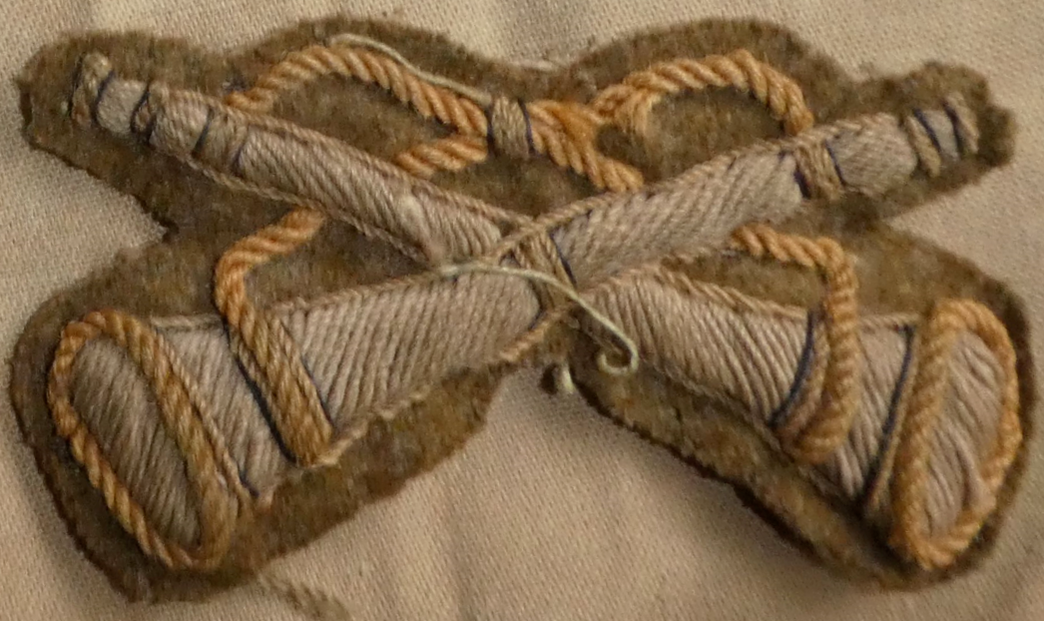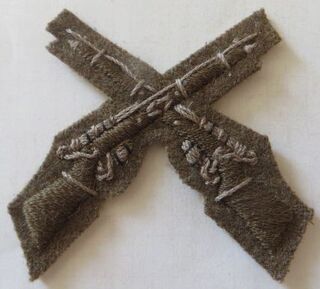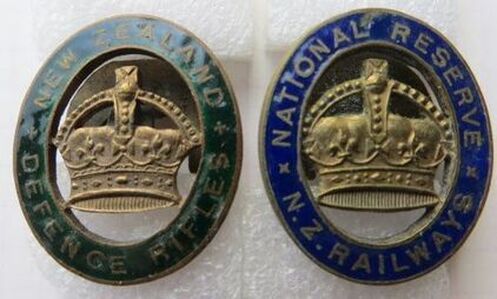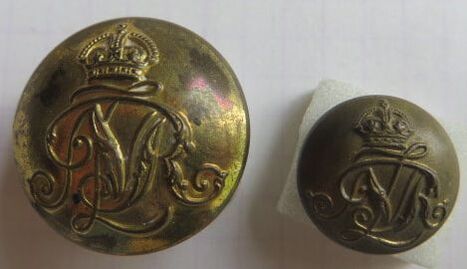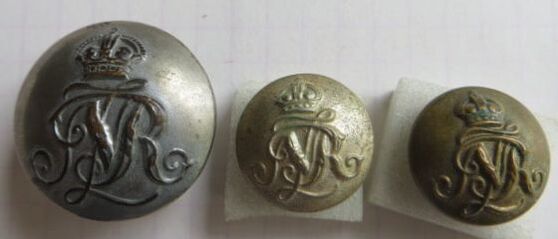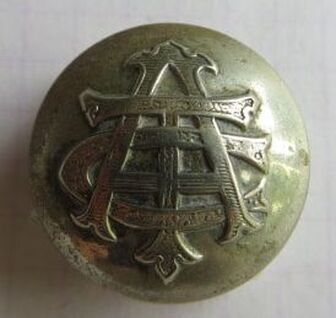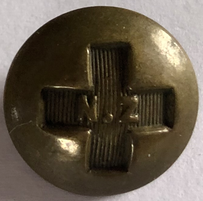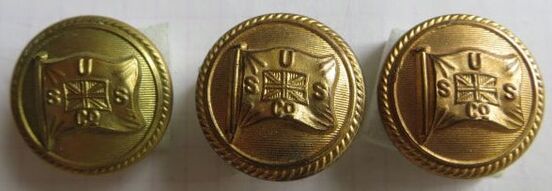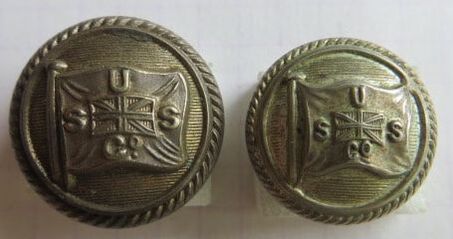New Zealand Other Items.
Returned Soldiers/Services Associations.
South African War Veteran’s Association
New Zealand's first major overseas war saw 6 495 Officers and men sent in 10 contingents to assisted the Empire in South Africa between 1899 to 1902. Thankfully many of them returned back to New Zealand when hostilities came to an end.
Like their WW1 counterparts, some 14 years later, they set up their own associations to look after the Soldiers and their families on their return.
Like their WW1 counterparts, some 14 years later, they set up their own associations to look after the Soldiers and their families on their return.
- Above: This is the standard and most commonly encountered South African War Veteran’s association badge in Bronze (member’s badge), Silver (Merit badge) and Gold (Life Members badge). Made by Mayer & Kean (Wellington) from 23rd of April 1933.

- Opposite: A South African War Veteran’s Association badge made from the 15th of December 1930 by Mayer & Kean (Wellington).
Possibly also made by W R Bock & Sons.
Sometimes called the “threepenny bit” because of its small size. Used by the SA Veterans in their journal "The Veteran" from the 1940s through to the 1950s.
Opinions differed as to whether or not it best represented the Association with as many supporters as detractors. Its limited survival these days may suggest that it was not retained or liked by many of the members.
Possibly also made by W R Bock & Sons.
Sometimes called the “threepenny bit” because of its small size. Used by the SA Veterans in their journal "The Veteran" from the 1940s through to the 1950s.
Opinions differed as to whether or not it best represented the Association with as many supporters as detractors. Its limited survival these days may suggest that it was not retained or liked by many of the members.
|
- Opposite: A First Contingent Association badge. Arguably the first South African Veteran’s Association badge.
Made by W R Bock & Sons (Wellington). Made in silver but a gold example was said to have been struck for Major A W Robin. - Above: A unusual variant on the South African War Veteran’s Association large Fernleaf. Possibly 1920’s in date to match the other, more common large badge.
Examples have mostly been found in the South Island so it is conceivable that this is a badge for this region. Made by Moller, Petersen (both Christchurch) or Swan (Dunedin). An association number crudely engraved to the rear. |

- Opposite: A large South African War Veteran’s Association badge (circa 1920’s).
Mentioned in contemporary press reports and used in advertisements for reunions. Good reason to describe this as an Auckland association badge. Examples found are unmarked but one has been sighted stamped “W H Worrall, Auckland” and all seem to have been struck on the same die with the misaligned “F” to “AFRICA”.
Referred to in "The Veteran" as “looking like a breastplate” when compared to the small round badge.
Mentioned in contemporary press reports and used in advertisements for reunions. Good reason to describe this as an Auckland association badge. Examples found are unmarked but one has been sighted stamped “W H Worrall, Auckland” and all seem to have been struck on the same die with the misaligned “F” to “AFRICA”.
Referred to in "The Veteran" as “looking like a breastplate” when compared to the small round badge.

- Opposite: A variant on the above badge with the addition of the word “WAR”. Reason for this is unclear but possibly to avoid confusion with supporters of South African sports teams touring New Zealand in the 20’s, the period when this badge was in general use. Lettering is placed differently suggesting that a new die was cut for this badge. This badge is encountered far less frequently than the standard large Fernleaf.
The addition of a small silver Fernleaf, riveted to the tip of the badge is to indicate distinguished service to the Association. The 1958 edition of "The Veteran" stated that these were obtainable from the firm of Gisborne jewelers Good & Co Ltd.
These were priced as “unmounted Gold 4/6, Silver 1/6, plus postage”.
The addition of a small silver Fernleaf, riveted to the tip of the badge is to indicate distinguished service to the Association. The 1958 edition of "The Veteran" stated that these were obtainable from the firm of Gisborne jewelers Good & Co Ltd.
These were priced as “unmounted Gold 4/6, Silver 1/6, plus postage”.
|
- Above & Opposite: A superb and very rare Wellington Branch members card to the South African Association. Above, to front, gives the objectives of the organisation, while to back, some rules.
The card is written out to a "W Tonkins" who is William Tomkins - 34412 / 20326 Trooper, 1st & 2nd Brabant's Horse. - 1109 Trooper, Colonial Light Horse. - 2366 Private, Duke of Edinburgh's Own Volunteer Rifles. - Cape Colonial Forces, Mercer's Special Squad. BH roll, 2nd BH, enlisted Cape Town, 26 November 1900, discharged Cape Town, 7 June 1901; 1st BH, enlisted Green Point, 11 June 1901, discharged Cape Town, 9 December 1901, completion of service, notes 'Prev serv NSWIB, subs serv SRGds' (WO127). |
(continued) QSA + CC, OFS, clasps; Tomkins has two roll entries as above, with clasps issued on each [CC, 1st BH; OFS, 2nd BH]; served other units as above: "Col Light Horse, struck off roll / served in DEOVR and returned as duplicate / served in Cape Col Forces, Mercer's Special Squad" (WO100/237, p248). Also SA01, SA02 clasps (WO100/237, p158).
Also as: 7/1149 S/Sgt W Tomkins, NZEF; Canterbury Mounted Rifles; 5th Reinforcements. Embarkation date: 13th June 1915. Enlistment address: Denniston, West Coast. Full name: William Tomkins. NOK: Mrs Florence Wagstaff (sister), London. Died 12 March 1939 (aged 75 years); labourer; buried South African War section, Karori Cemetery, Wellington; as 'Tompkins'. |
Footnote: the precise dating of South African Veteran’s Association badges is difficult as the organisation itself was somewhat disorganised in the beginning, with a good deal of local initiatives when it came to the creation of badges. The search for a universal badge seems to have never been quite achieved, although the small fern leaf would be the most plentiful and most recognised.
Why the fern leaf faces left and then right depending upon the period may never becompletely understood but may be the result of a desire to create a point of difference between regions.
Why the fern leaf faces left and then right depending upon the period may never becompletely understood but may be the result of a desire to create a point of difference between regions.
New Zealand Returned Soldiers/Services Association

The next War's first Returned Soldiers Association was formed in October 1915, in Dunedin. The ANZAC Club as it was called, was set up for discharged Soldiers from Trentham Camp, South African Veterans and disabled Soldiers of the current war which was happening at the time, i.e. WW1.
- Opposite: A Sterling Silver (marked to back) ANZAC Club badge numbered "386" to back. It is brooch fitted, and is stamped "StgSilver". The design was later modified for the Returned Soldiers Association (RSA) of New Zealand's badge going forward.
Further Soldiers Associations began then formed throughout the country, including the Auckland Returned Solders Association (A.R.S.A) on the 26th of Jan 1916.
- Opposite: A Sterling Silver (marked to back) ANZAC Club badge numbered "386" to back. It is brooch fitted, and is stamped "StgSilver". The design was later modified for the Returned Soldiers Association (RSA) of New Zealand's badge going forward.
Further Soldiers Associations began then formed throughout the country, including the Auckland Returned Solders Association (A.R.S.A) on the 26th of Jan 1916.
|
- Above: A Type 1 Auckland RSA badge made by William Reuben Watts (1869-1940). Number stamped to reverse with lowest number seen of this type being 10 and up to the 200 range. Badges were originally issued with a piece of swallow-tailed red ribbon like this example.
- Opposite: A WW1 NZ Soldier from the 6th (Hauraki) Infantry Regt, wearing his ARSA on his right breast, with ribbon. Note the crossed signal flags in brass on his right sleeve. |
|
- Above: A close up of the same soldier, with his ARSA badge and ribbon being worn.
|
- Above: A Type 2 Auckland RSA badge made by William Reuben Watts (1869-1940). Higher numbers for this badge type and note some detail differences to the ponga tree (where the frond hangs down over trunk). Possible that the die broke and a new one was cut.
|
Footnote: Page’s death in 1919 would suggest that Watts made the ARSA badge for a relatively short period (starting in 1916) and that possibly no more badges were made after Page’s death. ARSA members could “exchange” their badge for the standard RSA badge but it would appear that many chose to keep them as groupings of the both badges have been known to surface from time to time. At one stage, the ARSA placed an advertisement in the paper urging members of the public to hand in the ARSA badge if found as they were unable to obtain any more.
Numbers found on these badges are not service numbers and would have been only identifiable by records held by ARSA.
Numbers found on these badges are not service numbers and would have been only identifiable by records held by ARSA.

At a meeting held on the 26th of April 1916 in Wellington, it was voted on that a National Returned Soldiers Association be set up. All previous formed associations then agreed to "join" the New Zealand National Returned Soldiers Association (N.Z.R.S.A).
In June 1916 a large R.S.A badge (see opposite top) was agreed and adopted as the organisations membership badge. It was to have the Soldiers service number engraved (and sometimes stamped) to front.
Manufacturing of these badges was initially done by Mayer & Kean, 4 Willis Street, Wellington, New Zealand, who were granted the contract on 21st December 1916.
The badges were property of the New Zealand RSA, but relatives of the soldier were permitted to keep the badge after they passed.
They were not permitted to wear them.
- Opposite Top: A large, Silver, 1916 patt R.S.A badge to Trooper 7/1798 Laurie Albert Yarrall, a 7th Mounted Rifle Reinforcement, who service with the Canterbury Mounted Rifles. Note his service number is engraved to front. Size 43mm x 26mm and marked "SILVER" to back in raised letters.
On either side of the service number to front on the large badge is "RGD" and "861" or Registered Design 861 (it is on the back of the small badge, see below), which was registered on the 5th of June 1916 to the New Zealand Returned Soldiers Association Headquarters, Wellington, Box 199, GPO Wellington, N.Z.
This was extended on the 5th of June 1921 for 5 more years, and then again on the 5th of June 1926, for a further 5 years.
- Above Base: A small type post October 1927 Silver RSA badge to Trooper 7/1798 Laurie Albert Yarrall. This smaller badge was introduced due the old badge being considered too large by some, also with the smaller costing less. There was also some antagonism rumored, between the volunteers for WW1 (mainly chaps with a unit number then / or bar to their service number) and those who were conscripted (introduced on the 1st August 1916 - they had mainly a straight 5 digit service number only). This was all visible from the front of the large badge, but with the introduction of the small badge, the service number was moved to the back. Laurie's small badge has his service number "7/1798" stamped to back. Size is 22mm by 14mm.
Note the "date" plaque, which is added over the top of the Kings crown. This was introduced in 1941 to show that the wearer had paid his/her Association fee's for the year. Laurie's shows that he paid up to 1961. Each year tab was a different colour, and sadly this also sometimes indicates when an old Soldier dies, as it has his last "paid up" year before he passes.
In June 1916 a large R.S.A badge (see opposite top) was agreed and adopted as the organisations membership badge. It was to have the Soldiers service number engraved (and sometimes stamped) to front.
Manufacturing of these badges was initially done by Mayer & Kean, 4 Willis Street, Wellington, New Zealand, who were granted the contract on 21st December 1916.
The badges were property of the New Zealand RSA, but relatives of the soldier were permitted to keep the badge after they passed.
They were not permitted to wear them.
- Opposite Top: A large, Silver, 1916 patt R.S.A badge to Trooper 7/1798 Laurie Albert Yarrall, a 7th Mounted Rifle Reinforcement, who service with the Canterbury Mounted Rifles. Note his service number is engraved to front. Size 43mm x 26mm and marked "SILVER" to back in raised letters.
On either side of the service number to front on the large badge is "RGD" and "861" or Registered Design 861 (it is on the back of the small badge, see below), which was registered on the 5th of June 1916 to the New Zealand Returned Soldiers Association Headquarters, Wellington, Box 199, GPO Wellington, N.Z.
This was extended on the 5th of June 1921 for 5 more years, and then again on the 5th of June 1926, for a further 5 years.
- Above Base: A small type post October 1927 Silver RSA badge to Trooper 7/1798 Laurie Albert Yarrall. This smaller badge was introduced due the old badge being considered too large by some, also with the smaller costing less. There was also some antagonism rumored, between the volunteers for WW1 (mainly chaps with a unit number then / or bar to their service number) and those who were conscripted (introduced on the 1st August 1916 - they had mainly a straight 5 digit service number only). This was all visible from the front of the large badge, but with the introduction of the small badge, the service number was moved to the back. Laurie's small badge has his service number "7/1798" stamped to back. Size is 22mm by 14mm.
Note the "date" plaque, which is added over the top of the Kings crown. This was introduced in 1941 to show that the wearer had paid his/her Association fee's for the year. Laurie's shows that he paid up to 1961. Each year tab was a different colour, and sadly this also sometimes indicates when an old Soldier dies, as it has his last "paid up" year before he passes.

There were also reports at the time, that the new smaller badge was introduced in a an effort to clean up the membership, as a number of members wore the badge, but had not paid their dues, and a few civilians had also taken to wearing the badge without the correct authority.
With the new badges introduced, a clean up was seen to be made of the membership.
Sadly this didn't prevent the old "large" badge from still being worn and in some districts, for example Dunedin, members were offered the small badge if they traded in their old larger badge for free, but they could also purchase the new small badge for 2s 6d, and retain their old badge as well.
Each new badge was engraved with the soldiers service number at a cost of 3d, which was payable by NZ R.S.A headquarters, forwarded by the members branch.
- Opposite: A newspaper notice in the Evening Star, dated the 18th of Nov 1927, page 7, shows the introduction and cost (if members wanted to keep their old "large" badge) of the small RSA badge.
With the new badges introduced, a clean up was seen to be made of the membership.
Sadly this didn't prevent the old "large" badge from still being worn and in some districts, for example Dunedin, members were offered the small badge if they traded in their old larger badge for free, but they could also purchase the new small badge for 2s 6d, and retain their old badge as well.
Each new badge was engraved with the soldiers service number at a cost of 3d, which was payable by NZ R.S.A headquarters, forwarded by the members branch.
- Opposite: A newspaper notice in the Evening Star, dated the 18th of Nov 1927, page 7, shows the introduction and cost (if members wanted to keep their old "large" badge) of the small RSA badge.

- Above Left & Right and Opposite: Along with Laurie's two RSA badges, are also two of his paybooks (above) from WW1. The larger book covers from 6th of April 1917 to the 7th of April 1919. The smaller book is from the 4th of May 1919 to 22nd of Oct 1919. Above left shows Laurie's rate of pay as a Trooper in the Canterbury Mounted Rifles, of 2s per day. Between the 26th of Feb 1918 and the 30th of Mar 1918, Laurie received a extra 1s per day due to being appointed Cook.
- Opposite: Is Laurie's Certificate of Discharge, which every soldier in the NZEF received upon finally leaving the Army in New Zealand or where-ever they chose to be discharged (some were discharged in the UK). Laurie's certificate shows that he spent 3 years and 302 days overseas with the NZEF and was discharged on 15th of Oct 1919.
Laurie started his service on the 24th of Aug 1915, and had a total service of actually 4 years and 52 days, but much of the difference was spent in New Zealand Training.
Upper left in the opposite picture is the registered envelop which these certificates were sent in to the soldier, once home. Both are a mixture of cloth and waxed paper.
- Opposite: Is Laurie's Certificate of Discharge, which every soldier in the NZEF received upon finally leaving the Army in New Zealand or where-ever they chose to be discharged (some were discharged in the UK). Laurie's certificate shows that he spent 3 years and 302 days overseas with the NZEF and was discharged on 15th of Oct 1919.
Laurie started his service on the 24th of Aug 1915, and had a total service of actually 4 years and 52 days, but much of the difference was spent in New Zealand Training.
Upper left in the opposite picture is the registered envelop which these certificates were sent in to the soldier, once home. Both are a mixture of cloth and waxed paper.

In Jan 1917, Mayer and Kean lost their contract with the New Zealand RSA to Cecil Montague Bay, a fellow manufacturer at the time. Bay won a tender offered on the 10th of Jan 1918, to manufacture 3000 new badges. His badges also included a new safety ring to the back, which would allow a chain and safety pin to be attached. He had this "addition" registered as a RD or Registered Design under the number 1019, which is stamped to some of the ring, in minute detail.
RD 1019 is to Cecil Montague Bay (Jeweler and Engraver) , 66 Willis St, Wellington, NZ on the 10th of Jan 1918.
He also retro-fitted all existing stocks held by the NZ RSA for 3d per badge, with the ring, as papers at the time, show vets advertising for lost badges in the "Lost and Found" columns of the local papers.
RD 1019 is to Cecil Montague Bay (Jeweler and Engraver) , 66 Willis St, Wellington, NZ on the 10th of Jan 1918.
He also retro-fitted all existing stocks held by the NZ RSA for 3d per badge, with the ring, as papers at the time, show vets advertising for lost badges in the "Lost and Found" columns of the local papers.

On the 19th of September 1918, the NZ RSA announced that:
"Qualified nurses of the Colonial and Imperial Forces who have returned from active service shall be eligible for free honorary membership, and shall be supplied with a special badge issued under conditions identical with these governing the association badge" (Evening Post, Volume XCVI, Issue 70, 19 September 1918, Page 3).
- Opposite: Is a example of the large silver RSA badges presented to returning Nurses who were then members of the NZ RSA. Note the small silver and enamel cross to front. These are separately attached, and with the badge, being modified to allow the cross to sit flat to the front. A Nurses service number is always engraved to the back of the badge, no matter what size the badge is. There is also variation in the colour of the enamel to the cross to front.
Due to when these were offered in Sept 1918, all these large Nurses badges appear to be made by C M Bay and not Mayer and Kean, who were earlier with their larger badges.
Note that with the decrease in the badge size in Oct 1927, a small version of the Nurses badge was made with the cross, and they continue passed WW2, with a version for the Returned Services Association badge too. Also Queens crown RSA Nurses badge has been sighted.
Note too, a standard small "Soldiers" RSA Nurses badge has been sighted, with NO cross to front, but with the Nurses service number engraved to back.
Also announced on the 19th of September 1918 was that:
"All returned soldiers (officers and men) resident in New Zealand who have been honourably discharged, or are waiting honourable discharge, or have returned on duty or furlough and, who have, served in or with His Majesty's Forces Overseas during the great European war, shall be eligible for active membership" (Evening Post, Volume XCVI, Issue 70, 19 September 1918, Page 3).
This then allowed British, Australian, Canadian and other British Empire nations to join the NZ RSA. There seems to be no standard applied to their engraving, which could include their unit like “R.A.F.”, “R.F.A.”, “R.N.R.” or their British number on them.
The oldest sighted is to a Maori War's veteran with a “3 W.R.” to his badge and was with his New Zealand Wars medal that had been partially renamed, a combination of the impressing and engraving.
"Qualified nurses of the Colonial and Imperial Forces who have returned from active service shall be eligible for free honorary membership, and shall be supplied with a special badge issued under conditions identical with these governing the association badge" (Evening Post, Volume XCVI, Issue 70, 19 September 1918, Page 3).
- Opposite: Is a example of the large silver RSA badges presented to returning Nurses who were then members of the NZ RSA. Note the small silver and enamel cross to front. These are separately attached, and with the badge, being modified to allow the cross to sit flat to the front. A Nurses service number is always engraved to the back of the badge, no matter what size the badge is. There is also variation in the colour of the enamel to the cross to front.
Due to when these were offered in Sept 1918, all these large Nurses badges appear to be made by C M Bay and not Mayer and Kean, who were earlier with their larger badges.
Note that with the decrease in the badge size in Oct 1927, a small version of the Nurses badge was made with the cross, and they continue passed WW2, with a version for the Returned Services Association badge too. Also Queens crown RSA Nurses badge has been sighted.
Note too, a standard small "Soldiers" RSA Nurses badge has been sighted, with NO cross to front, but with the Nurses service number engraved to back.
Also announced on the 19th of September 1918 was that:
"All returned soldiers (officers and men) resident in New Zealand who have been honourably discharged, or are waiting honourable discharge, or have returned on duty or furlough and, who have, served in or with His Majesty's Forces Overseas during the great European war, shall be eligible for active membership" (Evening Post, Volume XCVI, Issue 70, 19 September 1918, Page 3).
This then allowed British, Australian, Canadian and other British Empire nations to join the NZ RSA. There seems to be no standard applied to their engraving, which could include their unit like “R.A.F.”, “R.F.A.”, “R.N.R.” or their British number on them.
The oldest sighted is to a Maori War's veteran with a “3 W.R.” to his badge and was with his New Zealand Wars medal that had been partially renamed, a combination of the impressing and engraving.
- Above: A post Oct 1927 Returned Soldiers Association small badge in Silver to 34899 Private Harold Mcleod, who hailed from Dunedin, and was part of D Company, 20th Infantry Reinforcements. He went on to served 1 year and 10 days overseas with the Otago Infantry Regiment.
Sadly Harold was wounded on the 29th of June 1917 in France, with gunshot wounds to the left thigh, and found "medically unfit". He was sent home to New Zealand to be discharged on the 5th of April 1918. In 1940, Harold re-enlisted to do his bit for WW2. His service number this time was 564217. He got to the rank of Staff Sergeant and served with various units based in New Zealand including the National Reserve and the 3rd Otago's. He was discharged on the 10th of Oct 1944.
Note the date tab to top of badge for the year 1964, on the reverse picture can be seen how the tabs fold in and around the side of the crown. Again, the badge is marked Registered Design number or "RD 861" to top reverse. Below is the maker mark of Mayer & Kean or "M & K" stamped, indicating that Mayer and Kean took back the contract at some stage later. Harold's WW1 service number is stamped to back of "34899". Sadly the pin has broken off the brooch fitting to back.
The initial small 1927 Returned Soldiers Association badges were made by Harry Thomas Peat. He was a veteran himself, serving with the 1st Battalion, New Zealand Rifle Brigade during WW1, with service number 23/1308. His badges can be found with the maker mark to back of "H.T.P", under the RD number 861.
Sadly Harold was wounded on the 29th of June 1917 in France, with gunshot wounds to the left thigh, and found "medically unfit". He was sent home to New Zealand to be discharged on the 5th of April 1918. In 1940, Harold re-enlisted to do his bit for WW2. His service number this time was 564217. He got to the rank of Staff Sergeant and served with various units based in New Zealand including the National Reserve and the 3rd Otago's. He was discharged on the 10th of Oct 1944.
Note the date tab to top of badge for the year 1964, on the reverse picture can be seen how the tabs fold in and around the side of the crown. Again, the badge is marked Registered Design number or "RD 861" to top reverse. Below is the maker mark of Mayer & Kean or "M & K" stamped, indicating that Mayer and Kean took back the contract at some stage later. Harold's WW1 service number is stamped to back of "34899". Sadly the pin has broken off the brooch fitting to back.
The initial small 1927 Returned Soldiers Association badges were made by Harry Thomas Peat. He was a veteran himself, serving with the 1st Battalion, New Zealand Rifle Brigade during WW1, with service number 23/1308. His badges can be found with the maker mark to back of "H.T.P", under the RD number 861.
In October 1941, the NZ RSA voted in favor of a name change, so no longer New Zealand Returned SOLDIERS Association, but instead New Zealand Returned SERVICES Association. This was seen as more inclusive, including both Men, Women and all services, i.e. Army, Navy and Air Force.
This also firmly dates badges by their title, with Returned Services Badges being associated with WW2 and beyond serving personnel.
WW1 Soldiers seemed to continue to wear their NZ Returned Soldiers Association titled badges.
- Top Left & Right: Is a small Returned Services Association badge in Silver, size 21mm X 13mm to 19488 Pte. Albert John Arbuckle of the 6th Reserve Mechanical Transport Company. Albert hailed from Dunedin, and enlisted in 1941. The 6th RMT Coy saw service in Libya, Egypt, Tripolitania, Tunisia and Italy. No maker mark and note the pin on the brooch fitting has broken off.
- Bottom Left & Right: A similar small Returned Services Association badge in Silver, size 21mm X 13mm to 461393 John William Arthur Rogers. John was from Wellington, and enlisted in 1942. His RSA badge has the date tab for 1945/1946 in red to show that he was a paid member of those years. No maker mark and note again the pin on the brooch fitting has broken off. A common fault.
This also firmly dates badges by their title, with Returned Services Badges being associated with WW2 and beyond serving personnel.
WW1 Soldiers seemed to continue to wear their NZ Returned Soldiers Association titled badges.
- Top Left & Right: Is a small Returned Services Association badge in Silver, size 21mm X 13mm to 19488 Pte. Albert John Arbuckle of the 6th Reserve Mechanical Transport Company. Albert hailed from Dunedin, and enlisted in 1941. The 6th RMT Coy saw service in Libya, Egypt, Tripolitania, Tunisia and Italy. No maker mark and note the pin on the brooch fitting has broken off.
- Bottom Left & Right: A similar small Returned Services Association badge in Silver, size 21mm X 13mm to 461393 John William Arthur Rogers. John was from Wellington, and enlisted in 1942. His RSA badge has the date tab for 1945/1946 in red to show that he was a paid member of those years. No maker mark and note again the pin on the brooch fitting has broken off. A common fault.

- Opposite: The Returned Services Association badge was also available with pin back, which sometimes also has a round brass clip which fits at the end of the pin (but which is often lost). This badge was issued to a WW1 veteran, 10/3697 Pte. William Henry Parkes, who served 2 years, 345 days overseas, initially with B Coy, 9th Reinforcements, then 16th Coy, 2nd Batt, Auckland Infantry Regt, then briefly 11th Coy, 2nd Batt, Wellington Infantry Regt, and finally attached to No. 1 Field Company, New Zealand Engineers. The badge has Williams service number stamped to back "10/3697". Size of badge 14mm by 22mm. Pin is 59mm long.
CHRISTCHURCH". Attached over the crown, via tabs is a brass crown tab for the year "79" for 1979. To back is a brooch bar, held on to back by two rivets. The pin has a ball catch.
Opposite is his membership card which also confirms he paid his $12 NZD subscription for the year of 1979.
Opposite is his membership card which also confirms he paid his $12 NZD subscription for the year of 1979.

- The surrounding badges are manufacturing trial pieces as follows:
- Above Left: A strike in brass (full thickness) made by C M Bay with an untrimmed surround. Possible to see if the dies were suitable to proceed with production.
- Above Center: A C M Bay strike that has been partially trimmed but is quite thin. It may be brass or nickel silver.
- Above Right: A double strike in brass by Mayer & Kean. It came from a Trademe (New Zealand) auction with lots of odd badges that were mostly unfinished - the seller said that they had belonged to his father or grandfather. It has been struck on a proper die but the “double register” to the front would have had it rejected had it been in silver. They have still used a “force” or back die to make this badge, so it must have been to check and see alignment of the dies.
- Above: A brass Mayer & Kean badge that had been very poorly cut out, and then had two lugs lead soldered to back. The purpose of this badge is unknown, but the collector in Tauranga had it for over 25 years. He may have cut it out and lugged it as he was a metalworker/ welder.
- Above Left: A strike in brass (full thickness) made by C M Bay with an untrimmed surround. Possible to see if the dies were suitable to proceed with production.
- Above Center: A C M Bay strike that has been partially trimmed but is quite thin. It may be brass or nickel silver.
- Above Right: A double strike in brass by Mayer & Kean. It came from a Trademe (New Zealand) auction with lots of odd badges that were mostly unfinished - the seller said that they had belonged to his father or grandfather. It has been struck on a proper die but the “double register” to the front would have had it rejected had it been in silver. They have still used a “force” or back die to make this badge, so it must have been to check and see alignment of the dies.
- Above: A brass Mayer & Kean badge that had been very poorly cut out, and then had two lugs lead soldered to back. The purpose of this badge is unknown, but the collector in Tauranga had it for over 25 years. He may have cut it out and lugged it as he was a metalworker/ welder.
New Zealand Returned Services Association Commemorative Badges
Over the years, the RSA badge itself has been commemorated.
|
- Opposite & Above: In 1991, the Wellington branch of the New Zealand Returned Services Association (NZRSA) manufactured a silver plated badge from one of the original dies of the large badge. This was to commemorate the 75 years since 1916, when the first badges were issued. It is flat back, and numbered "306" out of what we think is a run of 1000 (a 738 has been sighted). It has a single pin to back, to be used with a clutch. Above is the unfolded slip of paper, which is found in the lid of the opposite box, giving a brief history of the badge.
|
|
- Above: The Christchurch branch of the New Zealand Returned Services Association (NZRSA) also manufactured their own commemorative version of the large RSA badge. Made from a new die, its issue date is not known at this stage, but the badge is made from Stirling Silver, is flat backed, and had a brooch bar to back, with barrel catch on the pin. No maker mark, and with safety pin and chain which attaches to the hing of the brooch fitting. All in a blue case.
|
- Above: Again, the Christchurch branch of the New Zealand Returned Services Association (NZRSA) also manufactured their own commemorative version of the ANZAC Club badge. Issue date is not known, but the badge is made from Stirling Silver, is flat backed, and had a brooch bar to back, with barrel catch on the pin. No maker mark, and with safety pin and chain which attaches to the hing of the brooch fitting. All in a red case.
|
NZ Soldiers’ Association/Home Service League of NZ Incorporated

- Opposite: The more commonly found, later dated badge to the Home Servicemen's Association Inc of New Zealand. This badge comes with brooch fitting, as well as a long lapel pin to back.
Likely made from Sterling Silver, but it is not marked nor maker marked.
Stamped "MX 74060" in small letters/numbers to back, it also has the date tab, to show fully paid membership for the year 1981.
Size 19mm by 20mm.
Likely made from Sterling Silver, but it is not marked nor maker marked.
Stamped "MX 74060" in small letters/numbers to back, it also has the date tab, to show fully paid membership for the year 1981.
Size 19mm by 20mm.
Main Body Association
|
- Opposite Left and Right: A badge for the NZEF Main Body Association. An example of a “special interest” group based around those with a defined military service. Made by Young & Co, 20-22 Lorne Street., Auckland. Early issue badges probably numbered like the example shown but the majority are unnumbered. Mostly in silver plate, but possibly also made in sterling silver and not inconceivable that a gold example may exist, for a Life Member.
Headquarters were in Wellington with the first reunion to be held in October, 1937. Documents show the Association being formed as an Incorporated Society on 26th April 1938. The last official reunion held in 1974 but in July, 1989 there were still eleven members "alive”. |
- Note the opposite right badge has the soldiers details engraved to base. 12/270 CQMS Norman Veart of the 1st Batt Auckland Infantry Regiment, who served 4 years and 67 days overseas at Gallipoli (1915), Egypt (1915/1916) and France and the Western Front (1916, 1917, 1918).
Auckland Artillery Association
- Above Center Right: A gilt brass finished association badge for the Auckland Artillery Association. Not numbered in anyway to back, it has a stamping of "Young & Co, Auckland". Meaning unknown, but could just be a alternative finish to the Silver plate version. 24mm in diameter (image from the internet).
New Zealand Returned Soldier’s Ypres Club

The exact reasons for this dispute may never be known but may lie in the fact that a picture of a reunion dinner held in 1936 hosted the controversial broadcaster the Rev. C. G. Scrimgeour so was this a political, ideological or based on the title of the Club using the wording Returned Soldiers?
In any event, the Registrar of Companies attempted to contact the Club without success as they had not filed the required financial returns for some years. The Club was accordingly deregistered in July, 1943
- Opposite: A notice added by the NZ RSA with regards to the Ypres Returned Soldiers' Club (Auckland Star, Issue 66, 19th March 1938, page 23.
In any event, the Registrar of Companies attempted to contact the Club without success as they had not filed the required financial returns for some years. The Club was accordingly deregistered in July, 1943
- Opposite: A notice added by the NZ RSA with regards to the Ypres Returned Soldiers' Club (Auckland Star, Issue 66, 19th March 1938, page 23.
5 Battery, 1st NZEF
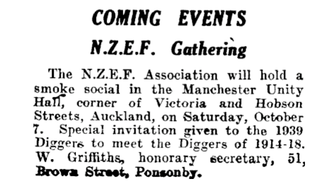
A 1937 mention of the association refers to it as the NZEF Association Social Club in connection with Health Camps.
In September 1939 this would appear to be the last significant mention of the group.
- Opposite: A excerpt from the Auckland Star, Issue 231, 30th September 1939, page 9.
In September 1939 this would appear to be the last significant mention of the group.
- Opposite: A excerpt from the Auckland Star, Issue 231, 30th September 1939, page 9.
American & British Empire Services Sports - 1918

On the 7th of September, 1918, at Stamford Bridge in London, the American & British Empire Service Sport games were held. It included a number of Kiwi soldiers, who were either stationed in the UK at the time, on courses or recovering from wounds. A grainy film, taken by the Royal Air Force, shows the win by Corporal J Mason, of the New Zealand Expeditionary Force win his race of the mile in 4 minutes and 20 seconds. He missed out on the quarter (mile) by a foot, to a British Army Rifleman.
By all account the RAF team dominated many of the sports held on the day. Corporal Mason's exploits were reported nearly two months later in New Zealand, in the Evening Star, 15th of Nov 1918, page 6.
- Opposite: A small Silver (marked to back) pin badge to the 1918 American & British Empire Services Sports. A American and British flag to top, with symbols of Canada (maple leaf) and New Zealand (fern leaf) to base. Brooch fitting to back, with the impress "STERLING" hallmark. Size 22mm by 18.5mm.
By all account the RAF team dominated many of the sports held on the day. Corporal Mason's exploits were reported nearly two months later in New Zealand, in the Evening Star, 15th of Nov 1918, page 6.
- Opposite: A small Silver (marked to back) pin badge to the 1918 American & British Empire Services Sports. A American and British flag to top, with symbols of Canada (maple leaf) and New Zealand (fern leaf) to base. Brooch fitting to back, with the impress "STERLING" hallmark. Size 22mm by 18.5mm.
WW1 Arm Badges
On the 19th of Feb, 1916, the New Zealand Government via the National Recruiting Board, introduced a set of 4 coloured Arm badges or "Armlets" which were to be worn by men on their right sleeve on civilian dress in the street to show that:
- Khaki (Drabjean) with a Red Crown - for men enlisted and waiting to be called up (see below)
- Scarlet with Yellow Crown - for men honorably discharged from the Expeditionary Force (see below)
- French Grey with Light Green Crown - men who had offered themselves for service in the war but had been rejected as "unable to fulfill Defence Department Requirements"
- Light Blue with White Crown - men who are engaged in an exempted industry
- Khaki (Drabjean) with a Red Crown - for men enlisted and waiting to be called up (see below)
- Scarlet with Yellow Crown - for men honorably discharged from the Expeditionary Force (see below)
- French Grey with Light Green Crown - men who had offered themselves for service in the war but had been rejected as "unable to fulfill Defence Department Requirements"
- Light Blue with White Crown - men who are engaged in an exempted industry
|
- Above: A newspaper article stating that this system was "revised" at the beginning of May 1916 (Lyttelton Times - 5th May 1916 - page 8).
- Opposite: A rare image of two men wearing what I presume is their drabjean or khaki armlets, showing that they were either awaiting call up, exempt from service or permanently rejected. The crown to the bands cannot be made out, but note that these bands were worn on the right arm. No names and no date (Nelson Libraries). |
The Khaki or Drabjean with Red Crown then covered all men "who place their services at their country's disposal; whether they have been accepted for the Expeditionary Force and are waiting to be called up; or have been rejected; or have been exempted under the authority of the Hon. the Minister of Munitions upon the representation by their employer that they are experts required in the manufacturing or supply of the essentials of war or on duties connected with the equipment or maintenance of troops".
- Above: A WW1 New Zealand Khaki or Drabjean Arm-badge or Armlet, issued to enlisted kiwi's yet called up and be in uniform, or rejected for service or in employment which was deemed "War essential". This might have been a move to stop the white-feather brigade from targeting men for not doing their bit. Size 60mm by 180mm (folded)
|
- Above: Inside the band is a oval "NZ Defence" with broadarrow stamp in black ink.
|
- Above: Each Arm-badge was issued with a card certificate, which containing the particulars of the bearer. The above I presume are either ballot numbers or class number of the wearer as they were "called up" under the National Conscription scheme. The Arm-badge appears to have been re-issued a number of times.
|
The men of military age were classed overall into 4 categories by the New Zealand Authorities
- First Division - single men without dependents
- A Class - Second Division - Married men without Children
- B Class - Second Division - Married men with one Child
- C Class - Second Division - Married men with two Children
From 1916, with the introduction of conscription, the authorities sort to just take men from the First Division, also included were about 500 men throughout New Zealand per month who turned 20 anyway (you could enlist at 19 with your parent written permission). By 1918, this was not enough to maintain the required numbers for the NZEF, and A Class - Second Division men were called up in the early part of that year, followed by B Class - Second Division later in 1918.
- First Division - single men without dependents
- A Class - Second Division - Married men without Children
- B Class - Second Division - Married men with one Child
- C Class - Second Division - Married men with two Children
From 1916, with the introduction of conscription, the authorities sort to just take men from the First Division, also included were about 500 men throughout New Zealand per month who turned 20 anyway (you could enlist at 19 with your parent written permission). By 1918, this was not enough to maintain the required numbers for the NZEF, and A Class - Second Division men were called up in the early part of that year, followed by B Class - Second Division later in 1918.

Recruitment Offices also classed enlisting men into two classes when a man signed up and given the "Distinctive Badge", i.e. the Drabjean armlet:
- A Class - allowing single men to pick a certain "date" on when they entered the New Zealand Army - up to 6 months in the future
- B Class - allowing single men to enter the New Zealand Army within 14 days notice being given
One presumes that these distinctions were made so that it allowed the recruit the ability to get their affairs in order, either at work or at home.
- Opposite: A cardboard certificate issues to I believe 37961 William George Barr on the 25th of May 1916. William would have also been given a "Drabjean" armlet, with red crown and "GR". Note the reason, which states he was "enlisted for service and is waiting to be called up with the 18th Reinf Draft in June". So a Class A recruit. Though William in fact became part of B Coy, 22nd Reinforcements on the 16th of Oct 1916 (image from Te Papa Collections Online - GH023122)
- A Class - allowing single men to pick a certain "date" on when they entered the New Zealand Army - up to 6 months in the future
- B Class - allowing single men to enter the New Zealand Army within 14 days notice being given
One presumes that these distinctions were made so that it allowed the recruit the ability to get their affairs in order, either at work or at home.
- Opposite: A cardboard certificate issues to I believe 37961 William George Barr on the 25th of May 1916. William would have also been given a "Drabjean" armlet, with red crown and "GR". Note the reason, which states he was "enlisted for service and is waiting to be called up with the 18th Reinf Draft in June". So a Class A recruit. Though William in fact became part of B Coy, 22nd Reinforcements on the 16th of Oct 1916 (image from Te Papa Collections Online - GH023122)
WW1 Discharge Badge
As WW1 progressed, it was realised that a badge or item of clothing was needed to mark out returning Soldiers who were coming home due to injury received during service overseas.
The first New Zealand soldiers returned to home in June 1915, and it was decided in Feb 1916 that a red armband or "Armlet" with a Gold crown and the letters "G" and "R" either side was to be worn by all soldiers that had been honorably discharged from the Army.
A card was also issued with the armlet, which was to be carried at all times when the armlet was worn. This Card of Authority to Wear was referred to as a B.R. 134 by the Army.
The first New Zealand soldiers returned to home in June 1915, and it was decided in Feb 1916 that a red armband or "Armlet" with a Gold crown and the letters "G" and "R" either side was to be worn by all soldiers that had been honorably discharged from the Army.
A card was also issued with the armlet, which was to be carried at all times when the armlet was worn. This Card of Authority to Wear was referred to as a B.R. 134 by the Army.
|
- Above: A "B.R. 134" to 43780 Trooper William MacMorland who sadly developed bronchitis on the voyage from New Zealand to Australia (which would then have then taken him by Australian Transport to the Middle East). He was discharged as "No longer physically fit", and on his discharge certificate (opposite) it records that he was issued the above "B.R. 134" and Armlet (bottom center in the opposite image - typed).
|
These Armlets were deeply unpopular with the men at the time, due to look and also practicality. Many complained that they had "done their bit", only to be issued with a piece of cloth, which "fell down" the sleeve, or turned, so that the crown faced in. They also commented that after a "few days in the sun" the crown and "GR" faded so fast that it look like you were wearing a red band.
|
- Above: A Scarlet armlet which has had the printed crown and GR in yellow ink embroidered over the top with yellow thread, in a attempt to show the emblem better (Auckland Museum Collection).
- Opposite: A rare image, as these are nearly impossible to be found in pictures, actually being worn!! Sadly a unnamed image of a Nelson man who is wearing both his Scarlet band or Armlet (with crown facing out!) and his large NZ RSA silver badge showing that he had truly done his bit and is a Returned Service Man (Nelson Libraries Collection). |

- Opposite: A large brass kings crown, which might have also been used to "add" over the top of the printed crown on both the Scarlet and Drabjean armlets when it faded. There are reports that the authorities at the time were cracking down on men embellishing their armlets with metal insignia (both types) in the newspapers (see The Armlet Badges, Dominion newspaper, Vol 9, Issue 2862, 29 August 1916, Page 6).
It has two thin copper wire lugs to back in a East/West configuration, with no maker mark. This could be a Warrant Officer 2nd Class Crown (worn at the end of each sleeve), and so far no pictures have been found of a modified armlet being worn. Size 43mm by 41mm.
Many men instead chose to wear their large Silver NZ RSA badge with pride on their lapel to show that they had done their bit.
In New Zealand, on the 1st of March 1918, the Silver War Badge was adopted from the British as the badge going forward to show that the Soldier had been honorably discharged from the war.
It has two thin copper wire lugs to back in a East/West configuration, with no maker mark. This could be a Warrant Officer 2nd Class Crown (worn at the end of each sleeve), and so far no pictures have been found of a modified armlet being worn. Size 43mm by 41mm.
Many men instead chose to wear their large Silver NZ RSA badge with pride on their lapel to show that they had done their bit.
In New Zealand, on the 1st of March 1918, the Silver War Badge was adopted from the British as the badge going forward to show that the Soldier had been honorably discharged from the war.
Above: A rare set, with Silver War Badge and cardboard certificate or "BR. 148" (BR stands for Base Records) to 31681 Cowper Millichamp Moore-Jones, who was a member of A Company, 19th Reinforcement for a matter of some 2 months, whereby he was classed as "unfit" and "CII", which meant that he was unfit for overseas duty, but could be fit for some role within New Zealand. He looks to have had a disability (issues with his leg), and was also quiet old (40 at time of call-up). His file is a interesting read, as even though he was certified by a Army Medical board as unsuitable. he was called up again in 1917. To qualify for his SWB he also need to show that he had been continuously employed by the New Zealand Army for a period of more than 7 days.
Overseas, those New Zealanders who had been discharged in the UK, received theirs badges in late 1917, for example, Sapper 28015 Herbert (Jack) John Jelley of the New Zealand Engineers was confirmed to wear the Silver War Badge on the 8th of Dec 1917. He had started his service 25th of July 1916.
Overseas, those New Zealanders who had been discharged in the UK, received theirs badges in late 1917, for example, Sapper 28015 Herbert (Jack) John Jelley of the New Zealand Engineers was confirmed to wear the Silver War Badge on the 8th of Dec 1917. He had started his service 25th of July 1916.
- Above: A page from the British New Zealand SWB roll, which was kept in London, and records the badges issued to Kiwi's who were discharged in the UK. Some pages to New Zealand Officers also exist and these both are available via British heritage sites subject to a fee. New Zealand's SWB roll is currently lost, and there is no current way of tracing NZ issued SWB back to the person they were issued to. On very rare occasions, numbers have been recorded on Soldiers discharge certificates, in the margin, and this can be viewed on-line, within their service record. But this is a exception, rather than a rule, with it just being down to some Army clerk being extra efficient.
|
- Above: Two early UK issued SWB to New Zealander's discharged there from the NZEF. To left is NZ82 and right is NZ159. Note the pin is configured in a East/West direction. later this would be vertical.
|
- Above: Left, NZ82 is to 10/3207 Jonathan Horn Burton who was discharged in 1917 to NOK in the UK. Right, NZ159 is to 24760 Frank Herbert Leake who like Jonathan was discharged in the UK in 1917.
|
|
- Above: A Silver War Badge to 3/3472 Pte. Martin Joseph Reidy with the words "For King and Empire, Services Rendered". With Crown and "GRI" or Georgius Rex Imperator (George, King and Emperor).
|
- Above: Back of Martin's S.W.B. It shows the prefix used on all New Zealand issued S.W.B's of "NZ" and then a number, which in this case is "NZ26349". Attached is a vertical pin, with sadly the hook missing. Earlier issued S.W.B have a horizontal pin, but this was found to break, so a vertical pin was introduced instead.
|
- Above: Is Martin's Victory medal, issued to him on the 2nd of Feb 1922. It is impressed with Martin's details to rim as follows "3/3472 Pte. M. J. Reidy N.Z.E.F.
|
|
- Above: A small silver (not marked) brooched collar badge to the 28th Reinforcements, owned by 3/3472 Pte. Martin Joseph Reidy. No maker marks to back.
- Opposite: A photo taken somewhere in France of 3/3472 Pte. Martin Joseph Reidy and his Sister, 22/292 Nurse Mary Anne Reidy (Registration number 1582). Martin was part of the New Zealand Medical Corps, while his Sister Mary, part of the New Zealand Army Nursing Service. |
Martin started his service on the 10th of April 1917 and was part of the 28th Reinforcement draft (hence the above badge). He proceeded overseas on the 26th of October 1917 on-board the H.M.N.Z.T 90 (His Majesty's New Zealand Troop Ship number 90), attached to the Ships Hospital. He arrived on the 19th of Aug 1917 and was initially attached to NZ Medical Corps Depo at Aldershot in the UK.
On the 7th of Nov that year he was attached to the 1st Field Ambulance in the field, in France.
Sadly on the 28th of March 1918, he received a gunshot wound to the right shoulder and left leg. Likely this would have be shell shrapnel (the Army didn't differentiate types of wounds), and this entitled him to the above SWB.
Evacuated from France to England, he spent the rest of the war recovering. Marked as medically unfit, he was placed on the NZ Roll, but didn't return to New Zealand until 4th of July 1919.
Mary was already a Nurse, prior to the War at Hamilton Hospital. She joined the New Zealand Army Nursing Service on the 17th of Jan 1916, and left on board the Hospital Ship SS Mahnoe, which was NZ's Hospital Ship No. 1. Mary served in Egypt (1916) and France at No. 1 New Zealand Stationary Hospital at Amiens (later moved to Hazebrouck). On the 19 August 1919, Mary was awarded a "Brought to the notice of the Secretary of State for War" for outstanding service.
On the 7th of Nov that year he was attached to the 1st Field Ambulance in the field, in France.
Sadly on the 28th of March 1918, he received a gunshot wound to the right shoulder and left leg. Likely this would have be shell shrapnel (the Army didn't differentiate types of wounds), and this entitled him to the above SWB.
Evacuated from France to England, he spent the rest of the war recovering. Marked as medically unfit, he was placed on the NZ Roll, but didn't return to New Zealand until 4th of July 1919.
Mary was already a Nurse, prior to the War at Hamilton Hospital. She joined the New Zealand Army Nursing Service on the 17th of Jan 1916, and left on board the Hospital Ship SS Mahnoe, which was NZ's Hospital Ship No. 1. Mary served in Egypt (1916) and France at No. 1 New Zealand Stationary Hospital at Amiens (later moved to Hazebrouck). On the 19 August 1919, Mary was awarded a "Brought to the notice of the Secretary of State for War" for outstanding service.

- Opposite: A center of a SWB which has been removed from its wreath, and a pin added to its back. No marks to back, though no doubt its in silver. It came with a British SWB to A201761 Pte. Edwin Drake Stainer, who was awarded his SWB no. B189214 on the 19th of May 1919. Edwin served from 12th Jan 1915 to 26th Mar 1919, initially with King's Royal Rifle Corps Depot and then as T/41/056591 in the Army Service Corps as a Driver. Unlike New Zealand SWB, British SWB are traceable back to the soldier they were issued to.
- Above & Above Right: A original boxed New Zealand SWB, numbered NZ6799. Recipient is unknown, but it is rare to find the badge in its box of issue.
Its been noted that the very early versions of British SWB (a number 127 has been sight) were flat backed. The above first versions (and beyond) of the New Zealand SWB were convex.
Its been noted that the very early versions of British SWB (a number 127 has been sight) were flat backed. The above first versions (and beyond) of the New Zealand SWB were convex.
Troop Transport Ships

The New Zealand government during the Boer War, WW1 and WW2 used civilian shipping companies to "transport" its troops to the theaters of war beyond its shores.
Early on these ships were chartered from a mix of some local but also foreign companies. During WW1 ships like the Maunganui and Tahiti belonged to the Union Steamship Company (New Zealand). The Arawa, Athenic and Waimana to the Shaw Savill and Albion Company (UK). The Star of India and Hawkes Bay to the Commonwealth and Dominion Line (Australia). The Ruapehu and Orari to the New Zealand Shipping Company (New Zealand) and the Limerick to the New Zealand and African Steamship Company (UK).
Some vessels saw continuous service, while others saw just one voyage.
The civilian crews wore the uniforms of their company, but were given a badge to be worn in their button-hole as a distinction that they were "On War Service". This may have just been for wear in civilian cloths, to stop them being chased by the white feather brigade while at home or off duty.
- Above: A gilt bras "On War Service H.M.N.Z. Transports". It has a large button-hole brass fitting to back and is maker marked to "C. M. Bay" or Cecil Montague Bay of Wellington. Size 26.5mm diameter.
Early on these ships were chartered from a mix of some local but also foreign companies. During WW1 ships like the Maunganui and Tahiti belonged to the Union Steamship Company (New Zealand). The Arawa, Athenic and Waimana to the Shaw Savill and Albion Company (UK). The Star of India and Hawkes Bay to the Commonwealth and Dominion Line (Australia). The Ruapehu and Orari to the New Zealand Shipping Company (New Zealand) and the Limerick to the New Zealand and African Steamship Company (UK).
Some vessels saw continuous service, while others saw just one voyage.
The civilian crews wore the uniforms of their company, but were given a badge to be worn in their button-hole as a distinction that they were "On War Service". This may have just been for wear in civilian cloths, to stop them being chased by the white feather brigade while at home or off duty.
- Above: A gilt bras "On War Service H.M.N.Z. Transports". It has a large button-hole brass fitting to back and is maker marked to "C. M. Bay" or Cecil Montague Bay of Wellington. Size 26.5mm diameter.
Commemorative Badges
A number of badges and tokens were struck throughout the years and sold as commemorative items to the general public. This allowed fund-raising for comfort funds for the soldiers and also to contribute to the war effort.
|
- Above: A small gilt brass token made by C M Bay which states "GOOD LUCK TO OUR BOYS AT THE FRONT - KIA-ORA". Impressed to back is "REG" and "802" for Registered Design 802.
|
- Above: A small gilt brass token made by C M Bay which has "KIA-ORA", the Southern Cross Star constellation, a map of New Zealand and a Fern with "NZ" to center. Marked in raised letters to front "REG" and "803" for Registered Design 803.
|
- Above: A small gilt brass and blue enamel medal commemorating New Zealand's first battle in WW1. In raised letters its says " DARDANELLES, SOUVENIR, COMMEMORATING OUR BOYS 1st BATTLE, 25th APRIL 1915". Maker marked to back to "Moller Dn" or Moller of Dunedin. Size 25mm diameter. A similar small tin and celluloid badge, with pin was produced and sold.
|
REG or Registered Design number "800" is unknown at this stage.
REG or Registered Design number "802" is unknown at this stage.
REG or Registered Design number "803" was to Cecil M Bay (Jeweler Engraver), 66 Willis Street, Wellington, N.Z. on the 1st of November 1915.
REG or Registered Design number "802" is unknown at this stage.
REG or Registered Design number "803" was to Cecil M Bay (Jeweler Engraver), 66 Willis Street, Wellington, N.Z. on the 1st of November 1915.
WW2 Volunteer Badge

At the outbreak of WW2, there was a requirement (like WW1) to distinguish whether someone had "volunteered" for service in the New Zealand Defense Force, or not. This was a attempt to again stop the unwanted "white feather" brigade chasing those who looked right for doing their bit of the country, but were thought to be shirking.
It was introduced on the 31st of May 1940, and was given for three categories
- Those who had volunteered for New Zealand Army, RNZAF or New Zealand Naval Service, but had yet to be called up.
- Those who had volunteered, but had been rejected on health grounds, or rejected due to their work profession been deemed "essential"
- Those who had been honorably discharged from the New Zealand Armed Forces.
This badge was issued with a small paper certificate, which needed to be carried, and present when requested by any Defense Force Officer, Military Police or Civilian Police. The certificate number matched the number stamped to back.
- Opposite: A gilt brass and enamel button hole badge for a New Zealand Defense Force Volunteer of WW2. Maker marked to back to "MK" in a circle, for Mayer & Kean. Stamped with the number "11150". Size 27mm by 16mm.
It was introduced on the 31st of May 1940, and was given for three categories
- Those who had volunteered for New Zealand Army, RNZAF or New Zealand Naval Service, but had yet to be called up.
- Those who had volunteered, but had been rejected on health grounds, or rejected due to their work profession been deemed "essential"
- Those who had been honorably discharged from the New Zealand Armed Forces.
This badge was issued with a small paper certificate, which needed to be carried, and present when requested by any Defense Force Officer, Military Police or Civilian Police. The certificate number matched the number stamped to back.
- Opposite: A gilt brass and enamel button hole badge for a New Zealand Defense Force Volunteer of WW2. Maker marked to back to "MK" in a circle, for Mayer & Kean. Stamped with the number "11150". Size 27mm by 16mm.
WW2 Discharge or Invalid Person’s Badge
Like WW1, New Zealand followed Britain's example again and awarded a badge to its wounded Soldiers of WW2.
On the 16th of July 1941, the New Zealand Government passed the "War Service Badges Emergency Regulations 1941".
It gave authority for the following two badges to be worn.
On the 16th of July 1941, the New Zealand Government passed the "War Service Badges Emergency Regulations 1941".
It gave authority for the following two badges to be worn.

The Invalid Persons badge (known as the "Kings Badge" in the UK) was initially issued by the New Zealand Ministry of Defence, to servicemen who, as a result of their injuries, had been discharged from active service.
Unlike the British examples, New Zealand did mark the back of their badges with a Serial number.
The badge was also issued with a certificate signed by the authority who issued the badge, and contained the particulars of the person to whom it was issued to, and the reasons for its issue.
The certificate had to be carried at all times, when the badge was worn, and was to be produced if asked by any officer of His Majesty's naval, military, or air forces, or by any constable, or by any other person authorized in that behalf by the Ministry of Defence.
Both badge and certificate could be replaced, if lost on "proof to the satisfaction of the issuing authority by statutory declaration and such other evidence as he may require that the badge theretofore issued to him has been destroyed, stolen, mutilated, or lost". A fee of 5s was charged to issue a new badge. There appears to have been no charge for a new certificate, but the word "Duplicate" was written or printed on it.
I don't believe that the badge was issued in any form of box or packaging, unlike the UK version.
The badge was made of Nickle Silver and was also noted on the service-persons file as "I P Badge NZ###" (where # is the number stamped to the back of the badge).
It came with two different fittings to back, a buttonhole fitting for men, or a brooch fitting for women.
Unlike the British examples, New Zealand did mark the back of their badges with a Serial number.
The badge was also issued with a certificate signed by the authority who issued the badge, and contained the particulars of the person to whom it was issued to, and the reasons for its issue.
The certificate had to be carried at all times, when the badge was worn, and was to be produced if asked by any officer of His Majesty's naval, military, or air forces, or by any constable, or by any other person authorized in that behalf by the Ministry of Defence.
Both badge and certificate could be replaced, if lost on "proof to the satisfaction of the issuing authority by statutory declaration and such other evidence as he may require that the badge theretofore issued to him has been destroyed, stolen, mutilated, or lost". A fee of 5s was charged to issue a new badge. There appears to have been no charge for a new certificate, but the word "Duplicate" was written or printed on it.
I don't believe that the badge was issued in any form of box or packaging, unlike the UK version.
The badge was made of Nickle Silver and was also noted on the service-persons file as "I P Badge NZ###" (where # is the number stamped to the back of the badge).
It came with two different fittings to back, a buttonhole fitting for men, or a brooch fitting for women.
|
- Above: Two New Zealand made "Kings Badge". To front is the cypher GRI for "Georgius Rex Imperator", and refers to King-Emperor George VI. With Kings crown to top and "For Loyal Service" around the outside wreath.
Size is 25mm diameter. |
- Above: The backs of the opposite badges. Left is a brooch fitting with the number "919" stamped to back. The right has a buttonhole fitting, which is stamped "2805". Both are marked "M & K, W" for Mayer & Kean, Wellington. The Men's version also has the Mayer and Kean logo stamped to the buttonhole fitting.
|

The same piece of legislation also introduced the Merchant Navy Badge. Again a similar badge was already issued in the UK. New Zealand's issued ones seem to be non-void and are again made by Mayer and Kean of Wellington.
They were not issued with a serial number to back, and were again made to ensure that other members of the public could see that the wearer was "doing his bit" even though he didn't wear a uniform.
They were not issued with a serial number to back, and were again made to ensure that other members of the public could see that the wearer was "doing his bit" even though he didn't wear a uniform.
|
- Above: A silver (not marked) New Zealand Merchant Navy Badge. Note the NZ differs from the UK, in that its non-void (Merchant Navy lapel badge, circa 1939-1945. Gift of Miss Flora Wythes, 1972.Te Papa (GH025887)).
|
- Above: The reverse of the same New Zealand Merchant Navy Badge. Maker marked twice, once to left side, center back to "M & K, W" for Mayer & Kean of Wellington. To the buttonhole fitting is the "MK" logo (Merchant Navy lapel badge, circa 1939-1945. Gift of Miss Flora Wythes, 1972. Te Papa (GH025887)).
|
The above pictures and some text were taken from Serial Number 1941/118 "The War Services Badges Emergency Regulations 1941".
New Zealand Memorial Cross
After WW2, the New Zealand Government sort to acknowledge the ultimate sacrifice some members of the New Zealand Armed Forces paid with their surviving relatives.
In December, 1946, it was announced that a memorial cross would be given as a "small tribute of gratitude from the government and people of New Zealand in memory of those who gave their life for their country".
In September 1947, the memorial cross was instituted and a full set of regulations published.
It set out the criteria of whom it should be awarded to, i.e. to a person who was residing in New Zealand and who was serving with either the New Zealand Armed Forces or its Allies, and who had fallen in a conflict with which the New Zealand Government was committed to. This also included merchant seamen who lots their lives at sea while a conflict New Zealand was committed to, was taking place.
The cross was awarded primarily to the Mother, but if they were not alive, then the Father, if he had died, then the eldest Sister, and if she did not exist then eldest Brother. Two crosses could be awarded, one to the direct family and also one to the widow, if the person was married at time of death.
Allan Ignatious Sutherland (1900 - 1967) a prominent New Zealand Numismatists and Medalist helped design the 1st type NZ Memorial Cross, and submitted his designs based on the WW1 Canadian Memorial cross to Peter Fraser (then Prime Minster of NZ - 1940 to 1949).
In December, 1946, it was announced that a memorial cross would be given as a "small tribute of gratitude from the government and people of New Zealand in memory of those who gave their life for their country".
In September 1947, the memorial cross was instituted and a full set of regulations published.
It set out the criteria of whom it should be awarded to, i.e. to a person who was residing in New Zealand and who was serving with either the New Zealand Armed Forces or its Allies, and who had fallen in a conflict with which the New Zealand Government was committed to. This also included merchant seamen who lots their lives at sea while a conflict New Zealand was committed to, was taking place.
The cross was awarded primarily to the Mother, but if they were not alive, then the Father, if he had died, then the eldest Sister, and if she did not exist then eldest Brother. Two crosses could be awarded, one to the direct family and also one to the widow, if the person was married at time of death.
Allan Ignatious Sutherland (1900 - 1967) a prominent New Zealand Numismatists and Medalist helped design the 1st type NZ Memorial Cross, and submitted his designs based on the WW1 Canadian Memorial cross to Peter Fraser (then Prime Minster of NZ - 1940 to 1949).
|
- Above: A sterling Silver, Canadian WW1 memorial cross to 192682 Private George Alvin Myers of the 42nd Infantry Battalion. George lost a leg in action at Vimy Ridge, but was sadly to die of Tuberculosis at home, age 20 on the 15th of Dec 1919. Note the "GVI" cypher for George V to center, and the Maple leaves at the ends of the crosses. Marked "STERLING" to back, with a "R" in a circle for Roden Brothers Ltd of Toronto, Canada. Size 35mm by 32mm (excluding suspension ring).
|
- Above: A 1st Type New Zealand Memorial Cross to 9044 Pte. John Thomas Wright, who was part of the 1st Echelon of the 20th Battalion which departed in 1940 of the 2NZEF. He sadly died on the 8th of June 1947 in his home town of Dunedin, aged 44. Note the "GRVI" cypher to center and the three Fern Founds to cross ends. marked "STERLING" with a "R" to rectangle for Roden Brothers Ltd of Toronto, Canada. Size 36mm by 34mm (excluding suspension ring).
|
- Above: A 2nd Type New Zealand Memorial Cross. This is a sample cross, and is not marked or issued with a persons name to back. Note the "ERII" cypher to center, and just two Fern Founds to cross ends. These crosses were issued with a brooch fitting to back and did not have a suspension ring. Marked "M & K" to back and "SILVER" for Mayer and Kean of Wellington.
|
|
- Above & Opposite: A 1st Type New Zealand Memorial Cross to 20617 Gnr. Frederick James Nicholls, who was killed on Active Service on the 2nd of January 1943, in Libya, and is buried at Tripoli War Cemetery. He was part of the 2nd Echelon and 5th Field Regiment. His cross comes in its original case and cardboard card.
|
On the 14th of August 1960, a new set of regulations was published to accompany the 2nd Type of New Zealand memorial cross. This was to be awarded to the families of the fallen, of post WW2 conflicts, with the Korean War being the first.
New Zealand Eagles Club
|
During WW2, thousands of US servicemen were stationed and passed through New Zealand on their way to the Pacific theater of War. Some US Soldiers met their wives in New Zealand, and to help repatriate the New Zealand women with their husbands after the war, an organisation called the New Zealand Eagles Club was set up to assist.
- Above: A Silver badge to the New Zealand Eagles Club (not New Zealand Engineers!). Brooch fitting to back, and marked "M & K" for Mayer & Kean of Wellington and "SILVER" (Image from the internet). |
- Above Right: A superb group photo of members (with their babies) of the New Zealand Eagles Club (Members of NZ Eagle Club with babies. Young Women's Christian Association of Wellington & Hutt Valley :Photographs. Ref: PAColl-7688-01-17. Alexander Turnbull Library, Wellington, New Zealand. /records/23095509).
In total, about 1400 New Zealand women would traveled to the United States as war brides. The Eagle Club was set up to swap information on the three Cs: cookery, customs and the Constitution. But they were then forced to wait. Space on ships was tight, and many did not sail until 1946, often three years after their marriage. Some waited in vain for the necessary application on their behalf by their husbands, receiving instead notices of intention to divorce. Others traveled to the US only to discover that they had to produce a bond of US$500 on arrival. Fiancées had to wait even longer for the necessary permissions, if these came at all. Some of those who made the journey found the culture more foreign and their new relatives more suspicious than they had hoped. The Eagle Club extended its membership to also the mothers of the wives who worried at home.
In total, about 1400 New Zealand women would traveled to the United States as war brides. The Eagle Club was set up to swap information on the three Cs: cookery, customs and the Constitution. But they were then forced to wait. Space on ships was tight, and many did not sail until 1946, often three years after their marriage. Some waited in vain for the necessary application on their behalf by their husbands, receiving instead notices of intention to divorce. Others traveled to the US only to discover that they had to produce a bond of US$500 on arrival. Fiancées had to wait even longer for the necessary permissions, if these came at all. Some of those who made the journey found the culture more foreign and their new relatives more suspicious than they had hoped. The Eagle Club extended its membership to also the mothers of the wives who worried at home.
Anzac Commemorative Medallion

The Australian and New Zealand Governments, in a joint effort, sort to commemorate the 50th anniversary of the Gallipoli landings on the 25th of April 1915 in 1965.
Some of the veterans were still alive at the time, and were entitled to, and issued with (in 1967), the opposite lapel badge, which was designed by Australian sculptor Raymond Ewers. Note, only the veterans were entitled to the lapel badge, while the medallion (see below) was issued to both veterans and their family's (including if the veteran had died).
Their name is engraved to the back, and comes with a wire clip which allows it to be worn though a button-hole on their jacket or lapel.
- Opposite: A bronze lapel badge, depicting Simpson (actually John 'Jack' Simpson Kirkpatrick) and his donkey assisting a wounded man, a laurel wreath, the date '1915' and the word 'ANZAC'. Engraved to back of this one is the name "M. HILL". Size 35mm by 23mm. Note these badges are sadly reproduced in large quantities now-a-days, so care needs to be taken.
Some of the veterans were still alive at the time, and were entitled to, and issued with (in 1967), the opposite lapel badge, which was designed by Australian sculptor Raymond Ewers. Note, only the veterans were entitled to the lapel badge, while the medallion (see below) was issued to both veterans and their family's (including if the veteran had died).
Their name is engraved to the back, and comes with a wire clip which allows it to be worn though a button-hole on their jacket or lapel.
- Opposite: A bronze lapel badge, depicting Simpson (actually John 'Jack' Simpson Kirkpatrick) and his donkey assisting a wounded man, a laurel wreath, the date '1915' and the word 'ANZAC'. Engraved to back of this one is the name "M. HILL". Size 35mm by 23mm. Note these badges are sadly reproduced in large quantities now-a-days, so care needs to be taken.
|
- Opposite Left & Above: The Gallipoli Medallion in its case of issue. Note the above reverse, which unlike the Lapel badge, features the map of Australia, New Zealand and the Southern Cross consolation. Size 76mm by 50mm.
|
- Above: The paper certificate from the New Zealand Government which comes with the medallion and lapel badge.
|
- Above: 8/2547 John Morrison Bucknor worked for the Union Steam Ship Company prior to WW1 as a Mariner, and listed his address as Wharf Hotel, Dunedin. He commenced his service on the 17th of April 1915, as part of D Company, 6th Infantry Reinforcements.
He was promoted to Corporal on the 31st of May 1915
He embarked for Egypt on the 14th of August 1915 from Wellington, and was admitted to hospital once he arrived.
He joined his unit the 8th Coy of the 1st Otago Infantry Battalion on the peninsular at Gallipoli where he held the rank of private on the 13th of Nov 1915.
John remained there till the 27th of Dec 1915, where he then disembarked back in Alexandria, Egypt as part of the general withdrawal.
He later went onto France where he served until April 1918, and then was discharged from the New Zealand Army on the 27th of May 1918 to be commissioned in the Royal Navy Reserve. It looks likely that he saw no action with the RNR, as he would have been training when the war ended.
Total service with the NZEF was 3 years and 41 days.
New Zealand issued him with a 1914-15 Star, but his record states that the British Admiralty were to issue him with his BWM and Victory medals.
John moved back to New Zealand at some stage, as its recorded that he died on the 13th of April 1970 at Wellington. He would have also claimed his Gallipoli Lapel badge with his above medallion, which sadly I do know the where-abouts of.
He was promoted to Corporal on the 31st of May 1915
He embarked for Egypt on the 14th of August 1915 from Wellington, and was admitted to hospital once he arrived.
He joined his unit the 8th Coy of the 1st Otago Infantry Battalion on the peninsular at Gallipoli where he held the rank of private on the 13th of Nov 1915.
John remained there till the 27th of Dec 1915, where he then disembarked back in Alexandria, Egypt as part of the general withdrawal.
He later went onto France where he served until April 1918, and then was discharged from the New Zealand Army on the 27th of May 1918 to be commissioned in the Royal Navy Reserve. It looks likely that he saw no action with the RNR, as he would have been training when the war ended.
Total service with the NZEF was 3 years and 41 days.
New Zealand issued him with a 1914-15 Star, but his record states that the British Admiralty were to issue him with his BWM and Victory medals.
John moved back to New Zealand at some stage, as its recorded that he died on the 13th of April 1970 at Wellington. He would have also claimed his Gallipoli Lapel badge with his above medallion, which sadly I do know the where-abouts of.
New Zealand Army Band
The New Zealand Army has always had bands and musicians associated with Regiments and its bases, since Volunteer times.
Much of what they wore early on was based on the British badges and insignia.
Much of what they wore early on was based on the British badges and insignia.
|
- Above: A Victorian crowned Bandsman's badge in white metal to center on a gilt brass background. No maker mark to back.
|
- Above: A similar Victorian crowned Bandsman's badge in white metal to center on a gilt brass background (Ian Hamilton Collection).
|
- Above: A reverse colours Victorian crowned Bandsman's badge in gilt brass to center on a white metal background (Ian Hamilton Collection).
|
|
- Above: A similar Victorian crowned Bandsman's badge in white metal or silver/silver plate (Ian Hamilton Collection).
|
- Above: A Victorian crowned Bandsman's badge in silver plate or chrome. Two looped lugs to back, no maker mark.
|
- Above: A Kings crowned Bandsman's badge in white metal to center on a gilt brass background (Ian Hamilton Collection).
|
|
Above, Top Left: A darkened brass, Queen Victorian Crowned Bandsman's' Cap badge, worn pre 1902.
Above, Top Right: Similar Bandsman's' Cap badge, but with Kings Crown and worn post 1902. Above, Bottom Left: A Kings Crown Bandsman's' Cap badge, but this time with no fretting to the center of the Lyre. Above, Bottom Right: A variation again, but this time personalised for the New Zealand Field Artillery Band, which has been engraved on a small plaque of silver (not marked) to center of Lyre. - Opposite: The two largest training camps in New Zealand during WW1 had their own bands. Opposite is a Cap badge to the Featherston Camp Trumpet Band. Two looped wire lugs to back in a North/South configuration. Trentham also had its own Camp band and badge. Which I do not have. Size of the FCTB badge is 32mm by 34mm. |
- Above: A close up of the silver plaque to center of the Bandsman's' Cap badge to the New Zealand Field Artillery Band.
|

- Opposite: To back on the end of one of the trumpets of the FCTB badges is the RD or Registered Design number of "RD 957".
It has been recorded that the Silver version of the FCTB badge has a "RD 958" number.
RD or Registered Design number 957 & 958 is to Trumpet Major Frederick Charles Chegwin, Featherston Military Camp, on the 26th of March 1917.
It has been recorded that the Silver version of the FCTB badge has a "RD 958" number.
RD or Registered Design number 957 & 958 is to Trumpet Major Frederick Charles Chegwin, Featherston Military Camp, on the 26th of March 1917.
During WW1, with the greatly expanded New Zealand Army, bands were formed in Training Camps and within Reinforcement drafts.
|
- Above: A large framed reinforcement frame with a Lyre sweated to to center. RD or Registered Design number "RD812" to front. To back are two hex type brass lugs, size 52mm by 43mm.
|
- Above: A small matching collar to the opposite cap badge in 2 piece, gilt brass. Reinforcement frame with a RD or Registered Design number "RD812" to front. To back are two hex type brass lugs, size 32mm by 28mm.
|
- Above: A 34th reinforcement frame, used as a generic Cap badge for further drafts. It has had the "NZ" removed to the center, and a Lyre sweated on. Two hex type brass lugs to back, with size being 43mm by 36mm.
|
RD or Registered Design number "RD812" was to Harry Gustav Mayer & Francis Douglas Kean (Artistic Engineers and Die Seters), trading as Mayer & Kean, 4 Willis Street, Wellington, N.Z. on the 6th of December 1915.
|
- Above: A 34th reinforcement frame, used as a generic Collar badge for further drafts. It has had the "NZ" removed to the center, and a Lyre sweated on. A brooch fitting to back, with extra gilt applied. Size is 33mm by 26mm.
|
- Above: A reinforcement Collar frame used around the 13th draft. It has had its center removed, and a Lyre sweated on. Two copper wire lugs to back, with size being 30mm by 28mm.
|
|
- Above: A Cap badge worn by the 34th Reinforcements and onwards, with the "NZ" removed and a separate Lyre from a sleeve trade badge attached to center (Ian Hamilton Collection).
- Opposite: A Cap and Collar badge set worn by the 34th Reinforcements and onwards, with a separate brass Lyre attached to center (Ian Hamilton Collection). |
|
- Above: A large Cap badge in two piece, with a separate brass Lyre sweated onto a Reinforcement frame (Ian Hamilton Collection).
|
- Above: A silver, two piece reinforcement framed Cap badge to a Bandsman. Separate Lyre attached to the center of the frame. Note it has a brooch fitting to back (Ian Hamilton Collection).
|
- Above: A slightly worn postcard of Sling Camp Orchestra (UK) dated the 1st of May 1918. All the above chaps appear to be wearing 2nd (South Canterbury) Infantry Regiment Collar badges, accept for the Officer, seated in the center (who's badges I can't make out). Note the Cello and Violin player on the left, seated. Both have Kings crowned Musicians badges to their right sleeves, above their rank stripes. Message in pencil to back says "Curly at far L picture. Thought it may have been better. Best Love Charles XXXXX".
|
- Above: A Buglers Sleeve badge in embroidered thread on a khaki wool background (Ian Hamilton Collection).
|
|
- Above: A Cap to a Bandsman or Musician from around WW2 and the 2NZEF. A Onwards badges frame has had its "NZ" to center removed and a Lyre sweated onto the frame.
|
|
- Opposite Top: A Bandsman's Helmet Plate to the 6th (Hauraki) Infantry Regiment. This is a cast white metal badge, hand-painted with two lugs to back and the maker initials of "PAC" to back.
- Opposite Bottom: A Bandsman's Helmet Plate to the Royal New Zealand Infantry Regiment. Again, cast white metal, with two lugs to back and is numbered "56". Above, a pair of cloth and embroidered shoulder titles to the New Zealand Army Band. - Top: A rather faded Yellow thread on a Red background to The Band of the New Zealand Army. - Bottom: A more modern Yellow thread on a Red background to the New Zealand Army Band. |
Marksman's Badge.
|
- Above: A Marksman Proficiency Sleeve Badge in gilt brass. Four wire looped lugs to back, with much of the gilt finish now dull with age. No maker mark.
Note this badge was also worn as mark of "appointment", on upper right arm, for qualified instructors |
- Above: A Marksman Proficiency Sleeve Badge in embroidered thread on a khaki wool background. No maker mark (Ian Hamilton Collection).
|
- Above: A similar Marksman Proficiency Sleeve Badge in embroidered thread on a khaki wool background. No maker mark, with size being 71mm by 75mm.
|
|
- Above: A similar Marksman Proficiency Sleeve Badge in embroidered thread on a khaki wool background. No maker mark. Note the differences in colour of thread (Ian Hamilton Collection).
|
- Above: Another variation of Marksman Proficiency Sleeve Badge in embroidered thread on a khaki wool background. No maker mark (Ian Hamilton).
|
- Above: A pre WW1 "Prize" Proficiency badge for "best shot company, squadron, band etc.", with 5 pointed star above crossed rifles. Embroidered thread on khaki wool backing. No maker mark to back (Ian Hamilton Collection).
|

- A pre-WW1 "Prize" Proficiency badge possible worn by Cadets or Volunteers, but facing to the left, which is unusual. Embroidered thread on a khaki background. No maker mark (Ian Hamilton Collection).
New Zealand National Reserve.
The New Zealand National Reserve, was a civilian home front organisation which had existed prior to WW1.
It formed with the New Zealand Defence Act of 1909, and was based on the UK Reserve system.
It was open to all Volunteers who had had previous Military service or were members of organisations such as the Red Cross and St Johns Ambulance.
Regional units were set up throughout New Zealand, and these had their own badge.
They came in two forms, with a button-hole attachment to back, or a brooch fitting.
The brooch fitting enabled the Female members to attache it to their blouse, but also it allowed the badge to be worn as a Cap badge.
Active members were coloured gilt crown within a enamel border, while honorary members were a silver crown within a enamel border.
It formed with the New Zealand Defence Act of 1909, and was based on the UK Reserve system.
It was open to all Volunteers who had had previous Military service or were members of organisations such as the Red Cross and St Johns Ambulance.
Regional units were set up throughout New Zealand, and these had their own badge.
They came in two forms, with a button-hole attachment to back, or a brooch fitting.
The brooch fitting enabled the Female members to attache it to their blouse, but also it allowed the badge to be worn as a Cap badge.
Active members were coloured gilt crown within a enamel border, while honorary members were a silver crown within a enamel border.
|
- Above: A gilt and enamel button-hole badge to the National Reserve Auckland New Zealand. Numbered "313" to back and marked "Rubin Watts"
|
- Above: A slight variation in gilt and enamel button-hole badge to the National Reserve Auckland New Zealand. Numbered "2413" to back and marked "Rubin Watts". Size 32mm by 25mm.
|
- Above Left: A gilt and enamel button-hole badge to the New Zealand Defence Rifles. No maker mark to back.
- Above Right: A gilt and enamel button-hole badge to the National Reserve NZ Railways. Maker mark to "Bock, Wellington" |
|
- Above Left: A silver and enamel brooched badge to the National Reserve Wellington New Zealand. Maker stamped to back to "Bock Wellington".
- Above Right: Another silver and enamel brooched badge to the National Reserve Wellington New Zealand. No maker mark to back, and note the darker blue enamel. |
- Above: A gilt and enamel badge to the National Reserve Wellington New Zealand. No maker mark to back, and its had its button-hole fitting replaced with a brooch fitting. Size 30mm by 24mm.
|
- Above: A gilt and enamel button-hole badge to the G7 Gisborne Branch in the Wellington Military District. Stamped to back is "BOCK WELLINGTON". Size 29mm by 25mm.
|
|
- Above Left: A silver and enamel brooched badge to the G7 Napier Branch in the Wellington Military District. No maker mark to back.
- Above Right: A gilt button-hole badge to the G7B Ruahine Branch in the Wellington Military District. No maker mark to back. |
- Above Left: A gilt and enamel button-hole badge to the National Reserve Wellington. No maker mark to back.
- Above Right: A gilt and enamel button-hole badge to the National Reserve Marlborough. Maker impressed to back to "Bock Wellington". |

Others National Reserve badges known:
Hamilton, Cambridge, Hawera, Hawera DRC (Defence Rifle Club with blue, red and green boarders), Patea, Palmerston North,
Well. Mil. Dist, G6, Oroua,
Well. Mil. Dist, G7, Wairoa,
Well. Mil. Dist, G7, Hastings,
Well. Mil. Dist, G7a,
Well. Mil. Dist, G7c, Gisborne,
Greymouth, Southland (blue border), Southland (maroon border) Women’s National Reserve - Canterbury, Post and Telegraph.
Note Officers of the National Reserves attached rank stars to the top and sides of their badge (I have seen examples in the past come up for sale), while Warrant Officers and below, wore chevrons to their uniform sleeves. Many units did NOT adopt a uniform as it was beyond many of its members pockets. But many did adopt a civilian Cap, and wore it with their badge.
The above information was taken from Barry O'Sullivans article "National Reserve badges of WW1".
Hamilton, Cambridge, Hawera, Hawera DRC (Defence Rifle Club with blue, red and green boarders), Patea, Palmerston North,
Well. Mil. Dist, G6, Oroua,
Well. Mil. Dist, G7, Wairoa,
Well. Mil. Dist, G7, Hastings,
Well. Mil. Dist, G7a,
Well. Mil. Dist, G7c, Gisborne,
Greymouth, Southland (blue border), Southland (maroon border) Women’s National Reserve - Canterbury, Post and Telegraph.
Note Officers of the National Reserves attached rank stars to the top and sides of their badge (I have seen examples in the past come up for sale), while Warrant Officers and below, wore chevrons to their uniform sleeves. Many units did NOT adopt a uniform as it was beyond many of its members pockets. But many did adopt a civilian Cap, and wore it with their badge.
The above information was taken from Barry O'Sullivans article "National Reserve badges of WW1".
- Above Left: A silver and enamel brooched badge to the National Reserve Canterbury. No maker mark to back.
- Above Right: A gilt and enamel button-hole badge to the National Reserve Otago. Maker marked to back to "Moller"
- Above Right: A gilt and enamel button-hole badge to the National Reserve Otago. Maker marked to back to "Moller"
WW2 Souvenirs.
Some New Zealand soldiers looked to remember their overseas experience either through photographs or via everyday objects they encountered while serving. Here are a few.
- Above: A Allied Army Military issue Italian 50 Lire note, made in 1943 and issued to troops who had landed and fought up the Italian peninsular. A New Zealand soldier has gotten his mates he was serving with, to note their name and town they came from.
- Above and Bellow: Similar to the Italian note, New Zealand troops were station in Noumea as the war moved to the Pacific. Both these 5 Franc notes have names and addresses of New Zealand soldiers who served in that theater of the war.
New Zealand's Marine Department.
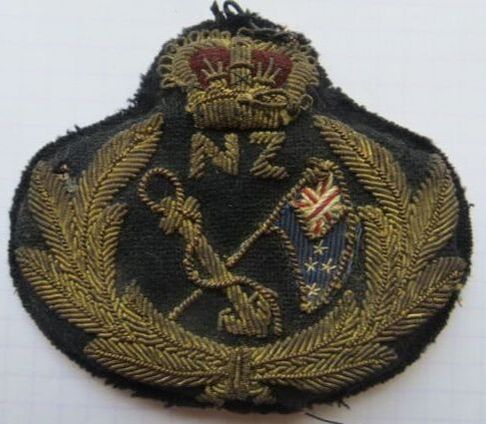
In 1863, New Zealand's Marine Board was set up as one of the first New Zealand Government Agencies to ensure Maritime Safety around New Zealand long coastline.
In 1866 the Marine Board was disestablished and the Marine Department was set up. Its goal was to "protecting the maritime transport sequence and marine environment within New Zealand and maintaining safety and security".
Among its duties was to maintain all lighthouses around New Zealand Coast. But in 1907, it acquired the 805 ton Royal Navy gun boat HMS Sparrow. This was converted into a training ship and renamed NZS Amokura.
Over the next 14 years 527 boys trained in Amokura, 25 of them going on to naval service and most of the others into the merchant marine.
In 1972 the Marine Department was absorbed into the New Zealand Ministry of Transport, which went on to set up what is now the modern day Maritime New Zealand.
- Opposite: A cloth and bullion thread Officers Cap badge to the New Zealand Marine Department. No maker label to back.
In 1866 the Marine Board was disestablished and the Marine Department was set up. Its goal was to "protecting the maritime transport sequence and marine environment within New Zealand and maintaining safety and security".
Among its duties was to maintain all lighthouses around New Zealand Coast. But in 1907, it acquired the 805 ton Royal Navy gun boat HMS Sparrow. This was converted into a training ship and renamed NZS Amokura.
Over the next 14 years 527 boys trained in Amokura, 25 of them going on to naval service and most of the others into the merchant marine.
In 1972 the Marine Department was absorbed into the New Zealand Ministry of Transport, which went on to set up what is now the modern day Maritime New Zealand.
- Opposite: A cloth and bullion thread Officers Cap badge to the New Zealand Marine Department. No maker label to back.
New Zealand Railways
The Railways started in New Zealand in 1863, with the Ferrymead Railway, but it wasn't until the 1880's that it truly became a national form of transport.
New Zealand Railways (NZR) or New Zealand Government Railways was formed as a Department in 1880 and then a Corporation from 1982. It was privitised in the 1990's and then became a state owned enterprise again in 2008. Today its is called KiwiRail.
Here are some of its buttons and button makers.
New Zealand Railways (NZR) or New Zealand Government Railways was formed as a Department in 1880 and then a Corporation from 1982. It was privitised in the 1990's and then became a state owned enterprise again in 2008. Today its is called KiwiRail.
Here are some of its buttons and button makers.
|
- Above Left: A 23mm, gilt brass, fixed shank button to the New Zealand Railways. Note Queen Victoria Crown. No maker mark.
- Above Right: A 16mm, copper (possibly silver plate), fixed shank button to the New Zealand Railways. Queen Victoria Crown, with maker mark of "Pereva et Prevale", with a picture of a Swan over water. |
- Above Left: A 24mm, gilt brass, fixed shank button to the New Zealand Railways. Note Kings Crown (post 1902), with maker mark to "H. B. Craighead Ltd, Wellington".
- Above Right: A 16mm, gilt brass, fixed shank button to the New Zealand Railways. Note Kings Crown (post 1902), with maker mark to "H. B. Craighead Ltd, Wellington". |
Huia Bruce Craighead started his business around 1932 in Wellington, with his family originating from Ashburton.
|
- Above: A 24mm, gilt brass, fixed shank button to the New Zealand Railways. Kings Crown, with rare maker mark to "ROSS & GLENDINING LIMITED, DUNEDIN NZ".
|
- Above Left: A 24mm, silver plated copper, fixed shank button to the New Zealand Railways. Maker marked to "Made in England".
- Above Center: A 16mm, frosted white metal, fixed shank button to the New Zealand Railways. Maker marked to "Made in England". - Above Right: A 16mm, gilt brass, fixed shank button to the New Zealand Railways. Maker marked to "Made in England". |
|
- Above Left: A 24mm, gilt brass, fixed shank button to the New Zealand Railways. Maker marked to "A Levy, Wellington".
- Above Right: A 16mm, gilt brass, fixed shank button to the New Zealand Railways. Maker marked to "A Levy, Wellington". |
- Above Left: A 24mm, gilt brass, fixed shank button to the New Zealand Railways. Maker marked to "A Levy Ltd, Wellington".
- Above Center: A 24mm, chromed brass, fixed shank button to the New Zealand Railways. Maker marked to "A Levy Ltd, Wellington". - Above Right: A 16mm, gilt brass, fixed shank button to the New Zealand Railways. Maker marked to "A Levy Ltd, Wellington". |
Abraham Levy (1861-1918) was a tailor, based in Wellington, supplying uniforms from around 1913. There has been take over the years that he also produced and marked New Zealand Force buttons, but I have yet to see one. Certainly he put his mark to New Zealand Railways buttons and I have a Officers New Zealand Army Service Corps WW2 tunic with his makers label to its collar (see NZ Corps A - N).
|
- Above:A 24mm , anodised aluminium button to the New Zealand Railways Corporation. This logo was used from 1982 to 1990. Maker marked to "Firmin London".
|
Tram Lines and Transport Companies.
|
- Above: A 23mm, white metal, fixed shank button to the Auckland Transport Board. Worn 1928 to 1964. A intertwining "ATB". Maker marked to "Stokes & Sons, Melbourne".
|
- Above: A 23mm, white metal, flexible shank button with brass backing to the Auckland Tramways Company. A intertwining "ATC". Maker marked to "Wm Dowler & Sons Ltd, Birmh".
|
- Above: A gilt brass (now toned) fixed shank, 23mm button to the Christchurch Tramway Board? A intertwining "CTB". Maker marked to "Fast Shanks".
|
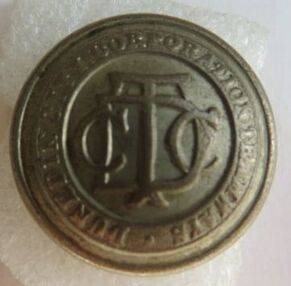
- Opposite: A white metal, fixed shank, 23mm button to Dunedin City Corporation Tramways. Brass backed, with brass fixed shank. Maker marked to "J R Gaunt & Son Ltd, London".
|

- Opposite: A gilt brass, fixed shank, 23mm button to the Wanganui Electric Tramways. A intertwining "WTC". Maker marked to "Buttons Ltd, Bham (cross swords) Trade Mark".
Whanganui had electric trams from Dec 1908 to Jan 1950, when they were then replaced by Buses. The City has restored some of it lines as a tourist attraction in recent years. |
Other.
|
- Above: A pair of gilt brass, fixed shank, 23mm and 19mm buttons to the Auckland Harbour Board? Unsure, so if someone can help it would be much appreciated. Intertwining "AHB" with a brass backing, but no maker mark to either.
|
- Above: A pressed, black bone, fixed shank, 22mm button to the Royal New Zealand Yacht Squadron. Maker mark to back to "Firmin London".
|
- Above: A pressed, black bone, fixed shank, 16mm button to the New Zealand Power Boat Association (N.Z.P.B.A). No maker mark to back.
The N.Z.P.B.A existed prior to WW1 and there are references in papers at the time that their members were associated with the NZ Forces Motor Corps, and certainly members joined the Royal Navy and Royal Naval Volunteer Reserves. |
|
- Above: A 24.3mm (also comes in 24.6mm), 1919 pattern, gilt brass New Zealand Red Cross Society button. Maker marked to "SPECIAL QUALITY" (B Jones collection).
|
- Above: A 17.4mm, 1919 pattern, gilt brass New Zealand Red Cross Society button. Maker marked to "SUPERB QUALITY" (B Jones collection).
|

- Above: A 24.5mm, gilt brass, unknown purpose button "NZ" to front. Maker marked to "SPECIAL QUALITY" (B Jones Collection).
|
- Above: A 17mm, gilt brass, unknown purpose button "NZ" to front. Maker marked to "SUPERB QUALITY" (B Jones Collection).
|
New Zealand Shipping Company.
The New Zealand Shipping Company was established in 1873, and was set up by New Zealand businessmen to counter the British dominance of the Shaw Savill Line (London to Auckland) and Albion line (Scotland to Dunedin). They would ship passengers and freight for the next 100 years, finally being taken over by the Peninsular and Oriental Steam Navigation Company (P&O) in 1973.
In WW1 it lost:
- Hurunui (2nd NZSC ship with that name) - torpedoed by U-94 on the 18th May 1918.
- Kaipara - stopped and sunk by SMS Kaiser Wilhelm der Grosse on the 16th of August 1914.
- Otaki (2nd NZSC ship with that name) - sunk by SMS Mowe on the 10th of March 1917.
- Rotorua - torpedoed by SM UC-17 on the 22nd of March 1917.
- Turakina - torpedoed by U-86 on the 13th of August 1917.
In WW1 it lost:
- Hurunui (2nd NZSC ship with that name) - torpedoed by U-94 on the 18th May 1918.
- Kaipara - stopped and sunk by SMS Kaiser Wilhelm der Grosse on the 16th of August 1914.
- Otaki (2nd NZSC ship with that name) - sunk by SMS Mowe on the 10th of March 1917.
- Rotorua - torpedoed by SM UC-17 on the 22nd of March 1917.
- Turakina - torpedoed by U-86 on the 13th of August 1917.

- Opposite: A full size Cap tally-band to the S.M.S. Moewe. It appears of the age, but there also seems to be a number of ways of spelling "Möwe" or "Moewe", which means "Seagull". The Moewe disguised itself as a neutral ship, thus allowing it to get close to Allied shipping, where it would then "open up" and sink its prey. In all it accounted for the sinking of 40 ships from 1914. It was taken out of service in 1917, as it had become to valuable a target and propaganda prize of the Allies had sunk it.
In WW2 it lost:
- Hurunui (3rd NZSC ship with that name) - torpedoed by U-93 on the 15th October 1940.
- Opawa - sunk by U-106 on the 6th of February 1942.
- Otaio - sunk by U558 on the 28th of August 1941.
- Paiko (2nd NZSC ship with that name) - torpedoed by U-107 on the 18th of May 1941.
- Rangitane - sunk by German raiders Komet & Orion on the 26th of November 1940.
- Remuera - sunk by torpedo delivered by aircraft on the 26th of August 1940.
- Rotorua (2nd NZSC ship with that name) - torpedoed by U-96 on the 11th of December 1940.
- Turakina (2nd NZSC ship with that name) - sunk by German raider Orion on the 20th of August 1940.
- Hurunui (3rd NZSC ship with that name) - torpedoed by U-93 on the 15th October 1940.
- Opawa - sunk by U-106 on the 6th of February 1942.
- Otaio - sunk by U558 on the 28th of August 1941.
- Paiko (2nd NZSC ship with that name) - torpedoed by U-107 on the 18th of May 1941.
- Rangitane - sunk by German raiders Komet & Orion on the 26th of November 1940.
- Remuera - sunk by torpedo delivered by aircraft on the 26th of August 1940.
- Rotorua (2nd NZSC ship with that name) - torpedoed by U-96 on the 11th of December 1940.
- Turakina (2nd NZSC ship with that name) - sunk by German raider Orion on the 20th of August 1940.
|
Above: A gilt brass, fixed shank, 23mm button to the New Zealand Shipping Company (NZSCo.). Maker marked to back to "G. Haysom Ld, Fenchurch St, London.
|
In 1912, the New Zealand Shipping Company took over the Federal Steam Navigation Company.
Above Left: A white metal, fixed shank 21mm button featuring both the New Zealand Shipping Company and Federal Steam Navigation Company flag emblems. Maker marked to "Miller, Rayner & Haysom Ld". Above Right: Similar 21mm, fixed shank, white metal button. Maker mark to "Baker & Co Ld, London". |
- Above Left: A combined, fixed shank, 21mm gilt brass button. Maker marked to "Miller, Rayner & Haysom Ld, Rd No.681006".
- Above Right: A combined, fixed shank, 21mm gilt brass button. Maker marked to "Firmin London". |
Union Steam Ship Company.
The Union Steam Ship Company of New Zealand Limited, was once one of the largest private employers in New Zealand.
It began in Dunedin in 1875 by James Mills, with a Scottish backer and operated throughout the coastline of New Zealand, with regular routes to Australia and Canada.
It was bought by Peninsular and Oriental Steam Navigation Company (P&O) in 1917. It was then on-sold to a Australian consortium in 1972, and finished up in 2000 after some 125 years in business.
It began in Dunedin in 1875 by James Mills, with a Scottish backer and operated throughout the coastline of New Zealand, with regular routes to Australia and Canada.
It was bought by Peninsular and Oriental Steam Navigation Company (P&O) in 1917. It was then on-sold to a Australian consortium in 1972, and finished up in 2000 after some 125 years in business.
- Above: A Officers peaked cap band and Cap badge to the Union Steam Ship Company. A gilt metal badge, with enamel to center on a black background with gold bullion thread wreath. No maker mark to either back of badge or cloth band.
|
- Above Left: A gilt brass, fixed shank, 25mm button to the Union Steam Ship Company. Maker marked to back to "Firmin & Sons Ld London".
- Above Center: A gilt brass, fixed shank, 22mm button to the Union Steam Ship Company. Maker marked to back to "Firmin & Sons Ld London". - Above Right: A gilt brass, fixed shank, 16mm button to the Union Steam Ship Company. Maker marked to back to "Firmin & Sons Ld London". |
- Above Right: A gilt brass, fixed shank, 21mm button to the Union Steam Ship Company. Maker marked to back to "Sword Trade Make Mark (with crossed swords) Made in England".
- Above Center: A gilt brass, fixed shank, 22mm button to the Union Steam Ship Company. Maker marked to back to "Special Quality". - Above Right: A gilt brass, fixed shank, 22mm button to the Union Steam Ship Company. No maker marked to back. |
|
- Above Left:A gilt brass, fixed shank, 22mm button to the Union Steam Ship Company. This has a more angled edge to back edge compared to the next button. Maker marked to back to "Firmin London".
- Above 2nd Left: A gilt brass, fixed shank, 22mm button to the Union Steam Ship Company. Maker marked to back to "Firmin London". - Above 2nd Right: A gilt brass, fixed shank, 18mm button to the Union Steam Ship Company. Maker marked to back to "Firmin London". - Above Right: A gilt brass, fixed shank, 16mm button to the Union Steam Ship Company. This has a more angled edge to back edge compared to the previous button. Maker marked to back to "Firmin London". |
- Above Left: - A gilt brass, bolt thread shank, 16mm Officers Shoulder Strap button to the Union Steam Ship Company. Maker marked to back to "Firmin London". The thread is approximately 7mm long.
- Above Right: A gilt brass, bolt thread shank, 16mm Officers Shoulder Strap button to the Union Steam Ship Company. Maker marked to back to "Firmin London". The thread is approximately 9mm long. Note the darkening behind the flag to make it "stand out". |
|
- Above Left: A white metal with brass backing, fixed shank, 22mm button to the Union Steam Ship Company. Maker marked to back to "Firmin London".
- Above Right: A white metal with brass backing, fixed shank, 18mm button to the Union Steam Ship Company. Maker marked to back to "Buttons Ltd, Bham (and crossed swords)". |
- Above Left: A white metal, with brass backing, fixed shank, 19mm button to the Union Steam Ship Company. Maker marked to back to "Special Quality".
- Above Center: A white metal, with brass backing, fixed shank, 19mm button to the Union Steam Ship Company. No maker marked to back. - Above Right: A white metal, with brass backing, fixed shank, 16mm button to the Union Steam Ship Company. Maker mark can not be made out. Possibly "Firmin London". |
|
- Above: A shoulder board pair to a Chief Engineer with Union Steam Ship Company. Both I material back, with a tie at one end and a sew-in USS Co button at the other. Both buttons are maker marked to "Firmin London".
|
- Above: A pair of cuff titles to a Chief Engineer with Union Steam Ship Company. The colour between the braid is in fact purple, but the light in the photo show it as a blue colour. No maker mark.
|
Northern Steamship Company.
The Northern Steam Ship Company Limited, served initially the northern half of the North Island of New Zealand from 1881 to 1974. It started out due to very few good roads, linking early coastal settlements in New Zealand. But sadly it over time, as road and rail links improved, it lost its market, until finally the last NSS ship berthed at Dunedin on the 8th of December 1974.
|
- Above Left: A 23mm, gilt brass, fixed shank button to the Northern Steamship Company. Maker marked to back to "Sword Trade Make Mark, Make in England".
- Above Right: A 16mm, gilt brass, fixed shank button to the Northern Steamship Company. Maker marked to back to "Sword Trade Make Mark, Make in England". |
- Above Left: A 23mm, white metal, fixed shank button to the Northern Steamship Company. Maker marked to back to "Sword Trade Make Mark, Make in England".
- Above Middle: A 18mm, white metal, fixed shank button to the Northern Steamship Company. Maker marked to back to "Sword Trade Make Mark, Make in England". - Above Right: A 15mm, white metal, fixed shank button to the Northern Steamship Company. Maker marked to back to "Sword Trade Make Mark, Make in England". |
Other Countries Shipping Buttons.
- Below: The Shaw Savill Line was a British company, was set up in 1858 to transport produce and people between Great Britain and New Zealand.
In 1860, a Glasgow based shipping line also formed, called the Albion Shipping Company, which was managed by P Henderson & Company.
In 1882, the two companies merged to form the Shaw, Savill & Albion Line.
It went onto run passengers and freight between Great Britain, Australia and New Zealand until 1975.
In 1860, a Glasgow based shipping line also formed, called the Albion Shipping Company, which was managed by P Henderson & Company.
In 1882, the two companies merged to form the Shaw, Savill & Albion Line.
It went onto run passengers and freight between Great Britain, Australia and New Zealand until 1975.

- Opposite Left: A gilt brass, fixed shank, 21mm button to the Shaw, Savill & Albion Line. Maker marked to "Miller & Sons, London & Southampton".
- Opposite Middle: A gilt brass, fixed shank, 19mm button to the Shaw, Savill & Albion Line. Maker marked to "Firmin London".
- Opposite Right: A gilt brass, fixed shank, 17mm button to the Shaw, Savill & Albion Line. Maker marked to "Monneey, London & Sutton".
- Opposite Middle: A gilt brass, fixed shank, 19mm button to the Shaw, Savill & Albion Line. Maker marked to "Firmin London".
- Opposite Right: A gilt brass, fixed shank, 17mm button to the Shaw, Savill & Albion Line. Maker marked to "Monneey, London & Sutton".
- Above: Two pages from a small autograph book which belonged to 2/3035 Pte. Frederick Thomas Lindroos of the New Zealand Field Artillery. He was part of the 11th Reinforcement draft to the N.Z.F.A, and then served oversea in France and the Western Front from Sept 1916. He happily survived the war and returned via Liverpool on the 27th of March 1919 on board the Shaw, Savill & Albion Line ship SS Kia Ora to New Zealand. On the left he managed to obtain the signatures of the Ships Officers on ANZAC Day, 25th of April 1919. On the Right is a superb pencil sketch of the boat done by a fellow passenger.
|
- Above: Gilt brass buttons to the British & Commonwealth Union Castle Line. Founded in 1900 with the merge of the Union Line and Castle Shipping Line. It wound up in 1990.
- Above Left: A 19mm, gilt brass fixed shank button to the Union Castle Line. Maker marked to back to "Kenning London". - Above Right: A 16mm, gilt brass fixed shank button to the Union Castle Line. Maker marked to back to "Kenning London". |
- Above: Gilt brass buttons to the British White Star Line. Founded in 1845, it was force merged by the British Government in 1934 to the Cunard Line.
- Above Left: A gilt brass, fixed shank 21mm button to the White Star Line. Maker marked to back to "Miller & Rayner & Haysom Ld". - Above Middle: A gilt brass, fixed shank 16mm button to the White Star Line. Note the larger star. Maker marked to "Peck's Liverpool". - Above Right: A gilt brass, fixed shank 16mm button to the White Star Line. Maker marked to back to "Rayner & Sons, Liverpool". |
|
- Above: A silver bullion and coloured thread on a black material background peaked Cap badge to the British India Steam Navigation Company. No maker name to back.
|
- Opposite & Above: items to the British India Steam Navigation Company. Founded in 1856, it merged with P & O in 1914, but continued to 1972 to have it own identity, when it then was completely taken over.
- Above Left: A gilt brass, fixed shank 25mm button to the British India Steam Navigation Company. Maker marked to back to "Firmin & Sons Ld London". - Above Right:A gilt brass, fixed shank 24mm button to the British India Steam Navigation Company. Maker marked to back to "S W Silver & Co. London". |
- Below: Buttons to the British Royal Mail Steam Packet Company. Formed in 1839, it went from a troubled start to being the largest Steam Ship line in the world in 1927. It was liquidated in 1932, due to scandal and miss-management, with it being reformed into the Royal Mail Lines.
|
- Above Left: A gilt brass, fixed shank 24mm button to the Royal Mail Steam Packet Company. Queen Victoria Crown, it has the maker mark of "Firmin & Sons 153 Strand & 13 Conduit St London".
- Above Left: A gilt brass, fixed shank 15mm button to the Royal Mail Steam Packet Company. Queen Victoria Crown, it has the maker mark of "Firmin London". - Above Right: A gilt brass, fixed shank 15mm button to the Royal Mail Steam Packet Company. Queen Victoria Crown, it has the maker mark of "C & J Weldon". |
- Above Left: A gilt brass, fixed shank 23mm button to the Royal Mail Steam Packet Company. Kings Crown, with George V cypher, it has the maker mark of "Miller Rayner & Haysom Ltd".
- Above Right: A white metal, fixed shank 21mm button to the Royal Mail Steam Packet Company. Kings Crown, with George V cypher, it has the maker mark of "Capital & Labour Stores Southampton". |
|
Above Left: A gilt brass 19mm, fixed shank button to the Orient Line. Maker marked to back to "Ed Stillwell & Son Ltd, London".
Above Right: A gilt brass 19mm, fixed shank button to the Orient Line. Maker marked to back to "Miller, Rayner & Haysom Ld". |
Above Left: A silvered 21mm, fixed shank button to the Orient Line. Maker marked to back to "Baker & Co Ltd, London".
Above Right: A silvered 16mm, fixed shank button to the Orient Line. Maker marked to back to "Baker & Co Ltd, London". |
The Orient Line was a British Shipping company founded in 1797. It primarily did the England to Australia run, and was eventually bought out by P & O in 1919. It continued to trade under the Orient Line brand until 1966.












